Paul Shier has been a friend of Slam City for many moons. His career spans decades and has involved different chapters, countries, companies, and a wealth of video parts. We caught up with Paul some distance from his spiritual home of Fairfield Halls, at his permanent residence in Los Angeles to discuss it all. The interview timeline follows his life on video to where he is at now, accompanied by amazing images from a wide variety of photographers who were more than happy to share their contributions to his narrative. Shier laid it down and did it right, paving the way for generations to follow and we are stoked he took the time to share his journey with us.
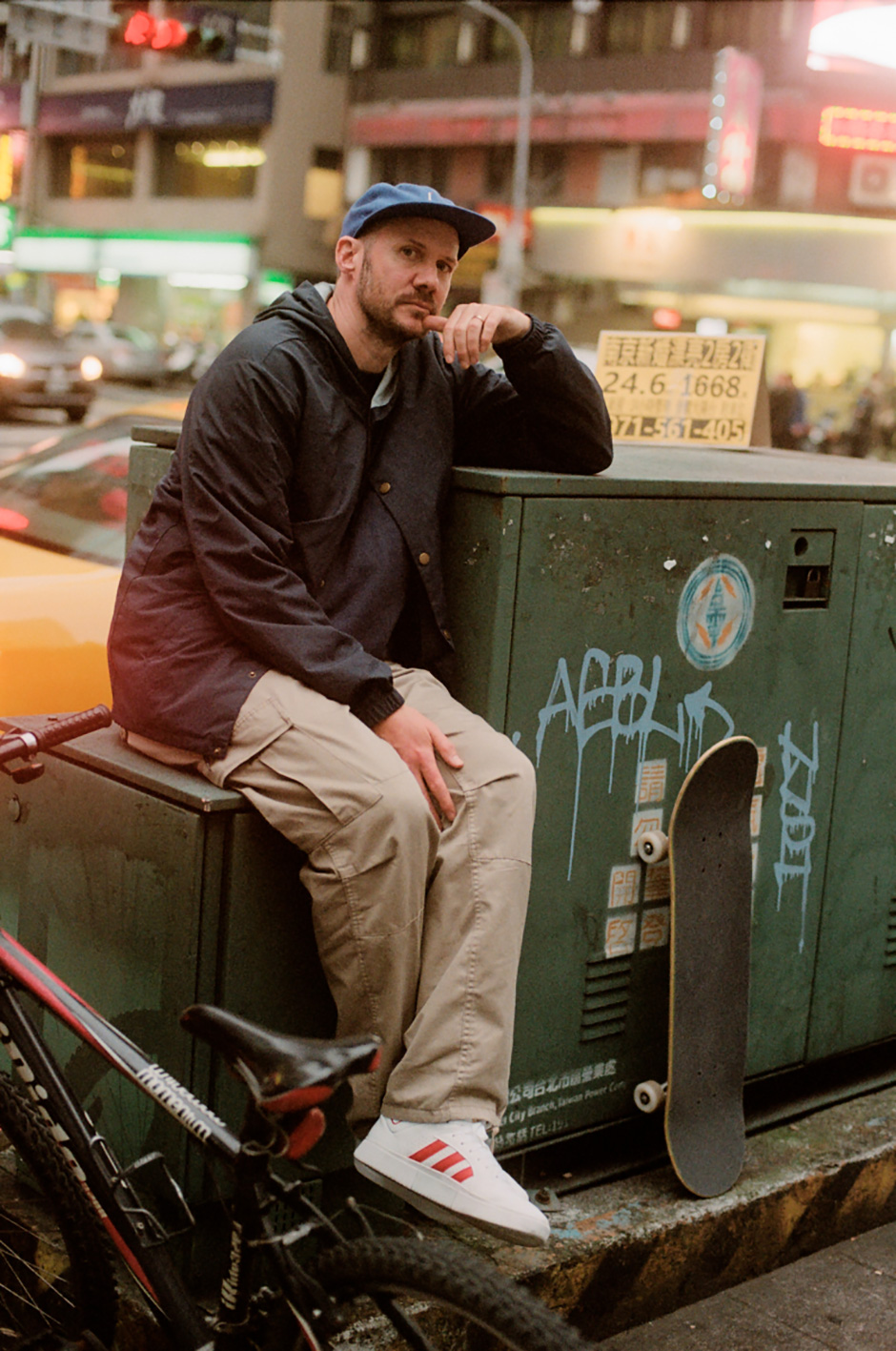
Words and interview by Jacob Sawyer. Paul Shier in NYC shot by Zander Taketomo.
Paul Shier is an inspiration on multiple fronts. He played a part in setting the standard for what it meant be a “professional” skateboarder from the UK in the truest sense of the word. He was also an integral part of Blueprint – the company and its videos – which bridged a transatlantic divide, in turn broadening the reach and opportunities for other European skateboard companies. With skateboarding as a compass he navigated school and different incarnations of the working world before turning pro and never looking back. He still approaches his job within the industry and his role at the company he started with the enthusiasm he had decades ago. Enthusiasm stemming from a love of skateboarding which sees him out skating more than many who are half his age.
Paul’s introduction to skateboarding was being blown away by seeing his friends Rob Roskopp board. His own first ride was less of a marvel, a fluorescent toyshop complete from the Whitgift Centre, featuring a clown on it, which nearly got him run over moments after purchasing it. That formative wake-up call was followed by his first experience of Fairfield Halls; so impactful he resigned himself to practising in his neighbourhood before returning there years later. A more functional hand-me-down Vision John Grigley mini board with Independent Trucks and Hosoi Rockets wheels set him on his path to progression. Shackle Me Not and Streets On Fire became his window into another world and Matt Hensley played a big part in what Paul and his friend Ryan emulated in their suburban training ground.
“It was, and continues to be, so challenging and rewarding.”
Before picking up a board changed Paul’s daily existence, he pursued a cross-section of sports. He played football, field hockey and cricket for his school, he was on a Sunday football team, swam for the Croydon Amphibians, and played a lot of tennis. Once skateboarding entered the picture, and Fairfields became his second home, that energy transferred.
“It was, and continues to be, so challenging and rewarding. I couldn’t think about anything else at that time,” says Paul, describing skateboarding’s entry into his life. Paul began honing his skills on the planters, stairs and found obstacles outside Croydon College. Those slabs would become intrinsically linked to his career.
This career-spanning interview delves into his life, on video, and beyond. It begins where the gravity of a random skater’s acid drop shocked Paul back to his neighbourhood until he felt confinement enough to return to a spot he’d skate like no other: Fairfield Halls. We have been lucky to publish a number of interviews with people whose careers began decades ago, but it’s a rare treat while compiling photos for the finished product that the interviewee comes back with photos shot in the last few months and with new footage on the boil.
The inspiration continues. Paul has picked up a tennis racquet again in recent years, a common story for many. It’s doubtful, however, that anyone who has done the same at this point in their life still packs such a mean 360 flip or has so many stories to tell.
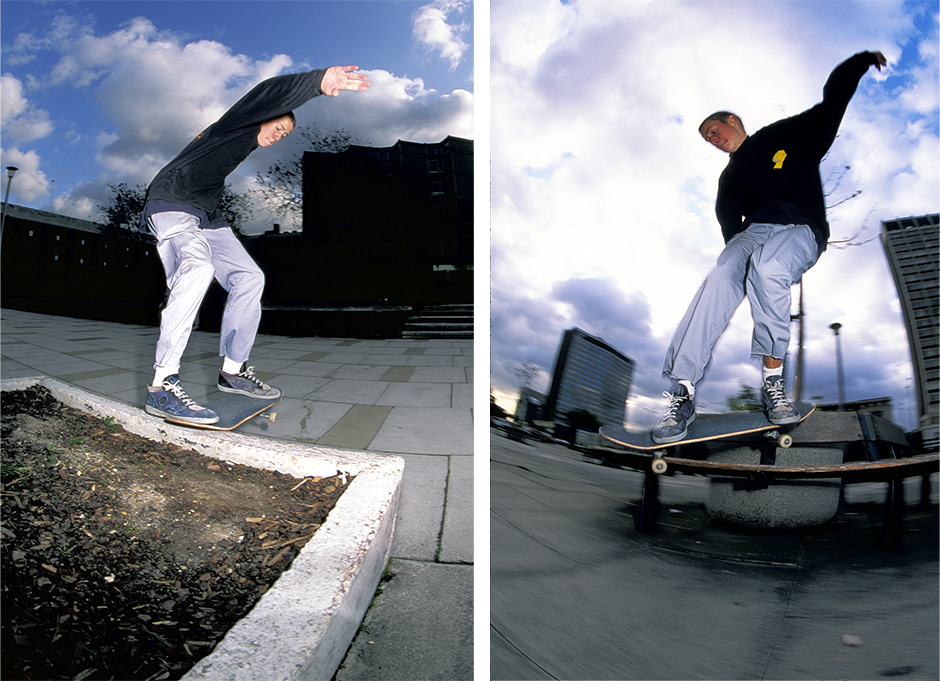
Square edged noseslide and a backside lipslide at Fairfields shot in 1991 on the same day as Paul’s RaD ‘INTRO’. PH: Tim Leighton-Boyce
Your life on video starts early. How did your appearance in the first 411VM [1993] come about?
Skin Philips may have worked for 411 or Giant [Distribution]. Even though he was the photographer, he came down to Fairfield and was filming as well as shooting.
Curtis McCann was there. We were just skating when he showed up. We had a little wooden bump over the planter and I did one of the worst kickflips ever documented, a double flip down four stairs and also…
A switch tre.
Was that in Issue 1? Yeah, switch the down the three.
Which is sick still.
Just three small stairs mate! Not too sick.
It was filmed on two separate days. The kickflip and the double flip was on the same day. The switch tre was another because I was skating with Elton Whybrow and he does a cab flip after me.
Skin filmed all that. I didn’t really know what we were filming for at the time. 411 wasn’t obviously “a thing” yet. So when it came out it in the London part, it was more of a surprise than anything else.
That kind of cemented you in the global skateboarding consciousness.
Maybe a little but I feel like that came later with my ‘Rookies’ 411 part. That was a turning point to where I went in this world.
What had happened already at that point? You had a sequence in RaD.
I had an ‘Intro’ in RaD doing a bigspin to boardslide at Fairfield. After that, a couple of “How To” sequences and we were also making local videos with Chris Aylen and James Mason.
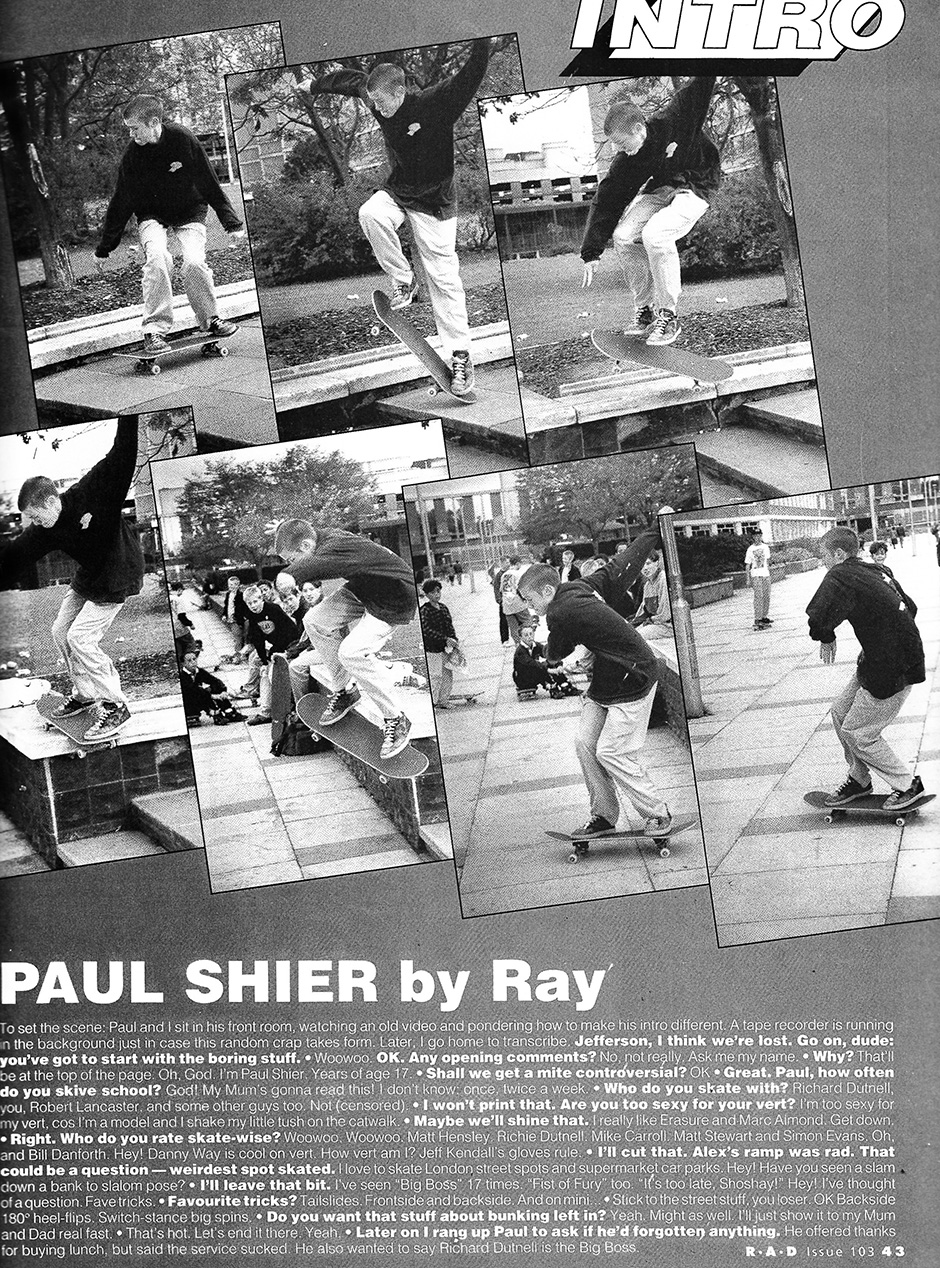
Paul’s first mag appearance in RaD Issue 103. Intro by Ray Calthorpe. ph: TLB
Skateboarding took over school at this point?
I wouldn’t say it “took over” school. It took over everything I’d been doing outside of school, extracurricular stuff.
I would do any available sport before skating but once I started at 13, it slowly changed. Then, all my close mates were mainly outside of school as no-one skated there. By the time I was frequenting Fairfield, I was playing no sport whatsoever. I just spent all my time skating.
So the interim of that 411 appearance and getting sponsored by PANIC was just heavy Fairfield localisation?
Everyday, yes. It had everything we needed.
Then a proper job entered the picture.
I was skating and being a teenager without a care, but got to a point where I couldn’t just do that anymore. I got a job at a Beefeater restaurant through my sister. I was making desserts but that didn’t last too long. Then I worked for Direct Line selling car insurance over the phone when I was 17/18.
And this meant your parents were stoked?
My mum was over the moon that I finally I had a “proper job” – whatever that is – sitting in an office on the phone. Once the company wanted me to work weekends, I was over it pretty fast. They asked me to go twice. I didn’t show and that was that.
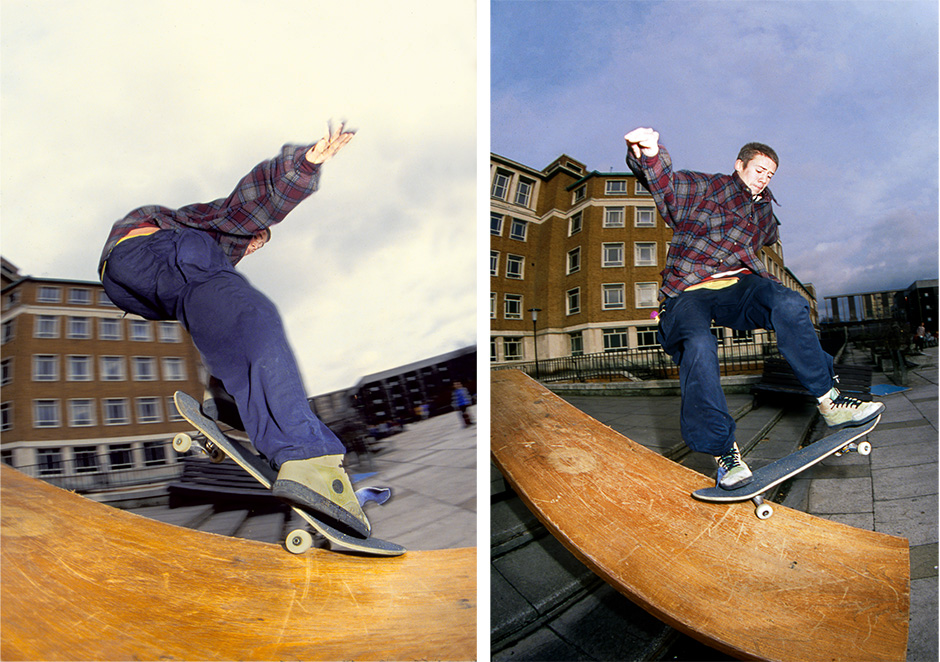
Airwalk Enigma clad crooked grind and 180 to fakie nosegrind on a Croydon College furniture find, 1992. ph: TLB
You would have literally been around the corner too. When did you first go to San Francisco?
Yes! That insurance office was just around the corner from Fairfield.
The first trip I took to America was to Sacramento, I went with Ray Man when I was 18. He had some pen pals out there so we stayed with them. Nick Tershay lived there at the time and he took us to SF for the day.
Going to Embarcadero, it was crazy at its height – that Jovontae [Turner] and Mike Carroll era. It was so brief. I remember skating a little bit but it that doesn’t sit as a strong memory, only the people I saw. I was a fanboy more than anything at that point.
The equivalent of an open-top bus tour.
Exactly! We didn’t do anything other than Embarcadero though. We took the two-hour drive there, parked right next to it, saw everything going down, rode on the bricks a little bit and then drove home to Sacramento. America was a completely new experience for me and I was tripping on how small Embarcadero seemed.
“If I sent a box of shoes – they were for Nick, Mike Carroll, and Rick Howard at that time – they’d send a box of product. I sent them then nothing ever came so I thought they forgot…”
I feel like lots of people made the pilgrimage to America and came back with tales. But your stints out there are like a continuation of what Bod Boyle, Steve Douglas and Don Brown did, nurturing those transatlantic relations to the point where the people you met then are still part of your story now.
For sure. I didn’t go back again until I was 21, that’s when I met a lot more people who I’m still close with today. Cairo Foster, Kenny Reed, Justin Strubing, Lee Smith, Karl Watson. I work real close with Karl at adidas, Karl and Lee [Smith] were the first people who introduced themselves in S.F and were interested in who we were, where we came from, and what we had to say. I hold that memory close.
After that, I ended up staying in the Van Ness house with Cairo or Kenny [Reed], Shawn Connolly and Kyle Demers in the Tenderloin. One bedroom. As we all did at that time, you just sleep wherever you can. All those people I met then, the majority I’m still very close with today.
“Four or five months later a box randomly turned up at my house. They’d sent it by boat. A big World Industries box with the Natas [Kaupas] “Satan” graphic on it, full of everything I wanted at that time.”
What was the Makro’s shoes hack? You’d bring shoes to trade for product?
That’s going back to the first trip. I might have had yellow Clyde’s or something, nubuck with a black sole. Makro was like a Costco-style place where you could buy anything in bulk. It just turned out they had affordable shoes and the ones that we wanted.
Nick Tershay asked me if I could send some shoes out to them in return for product. I could buy them for £10, £15 and they were something everyone wanted at that time. Ed Loftus took them all out with him when he moved out there. I think that’s how it started.
He said if I sent a box of shoes – they were for Nick, Mike Carroll, and Rick Howard at that time – they’d send a box of product. I sent them then nothing ever came so I thought they forgot.
Four or five months later a box randomly turned up at my house. They’d sent it by boat. A big World Industries box with the Natas [Kaupas] “Satan” graphic on it, full of everything I wanted at that time. Plan B boards, Blind wheels, [Guy] Mariano boards, Fuct clothing, a written note from Rick. It was, however, just a one-time thing.
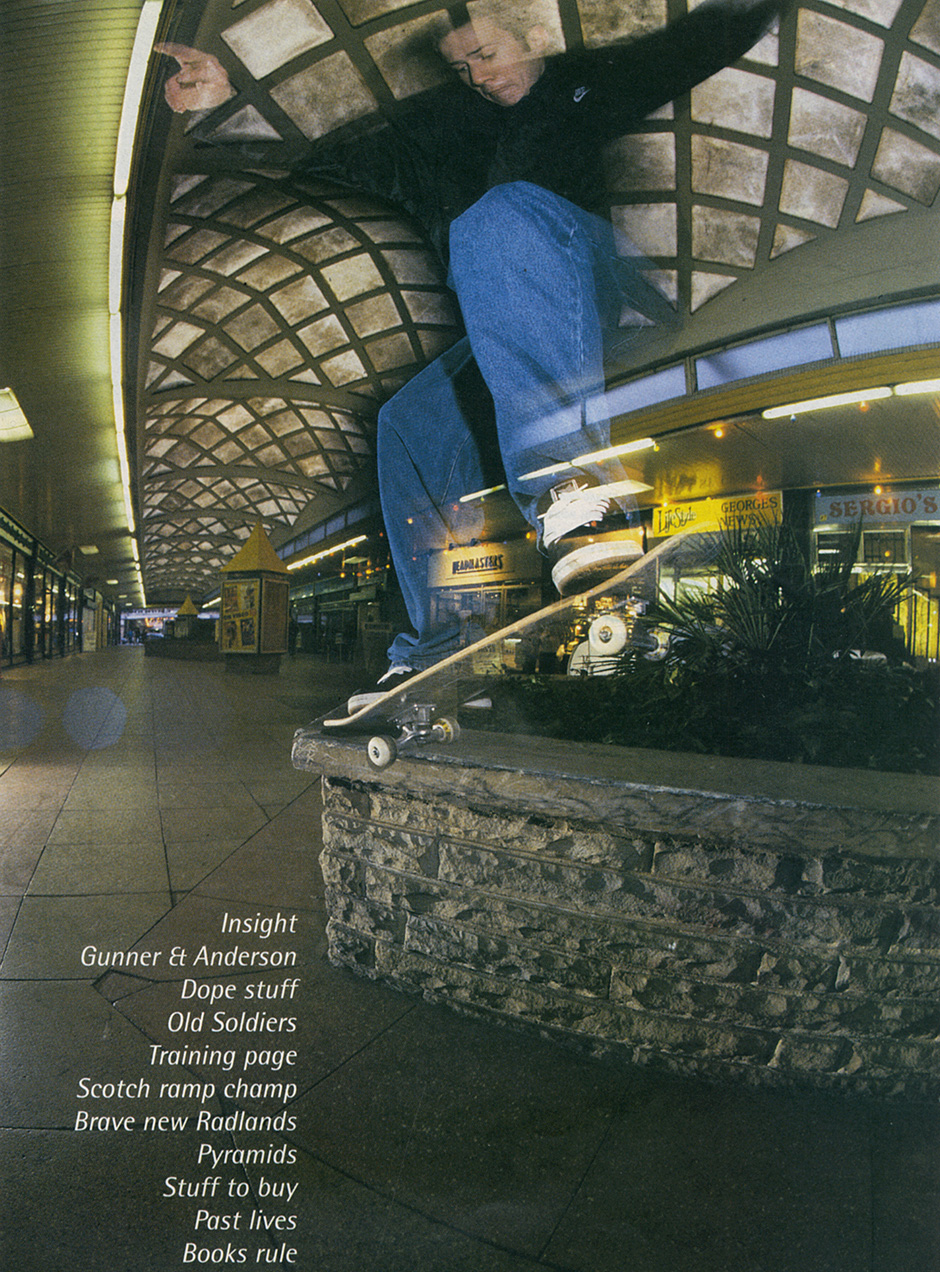
Backside nosegrind revert a stone’s throw from Fairfield Halls. ph: Andy Horsley
“It went so fast from Fairfield to pro contests.”
Then you get sponsored by Panic in 1995.
My first free board was a Bigspin. I asked Alvin [Springfield] if I could get some boards and he sent me just one. I think it was an 8.375” which, at the time, was massive. I remember sucking it up, setting it up, then having the most terrible setup with mini trucks and a huge board.
I drove up to a Wakefield contest [at Rehab Skatepark] a few weeks later from Croydon and asked Alvin if I could ride for Panic. He straight up told me “no” but some days later it worked out.
And a pro board followed very quickly.
I had a pro board two months after getting on. Alvin called and asked if I wanted to enter the contest at Radlands.
I was under the impression you had to be pro to skate it so when I asked him, his reply was just, “Well, do you want to be pro then?” I remember just saying “okay” over the phone and that was that.
I had this “kung fu” board. I’d never done kung fu in my life but I had a board with my name on it and some kung fu graphic that was probably plucked from some spot in Essex and plonked on a Panic board. Don’t get me wrong, I was so stoked, but it went so fast from Fairfield to pro contests.

Two of the first Paul Shier pro boards for Panic from 1996. ph: Jason Davey
You were working at the time. Did you straight up quit when that happened?
I was working night shifts at Gatwick airport as a check-in agent. I was asked to go on a Panic tour and instead of asking for time off, I would call work from the road at 2am to say I was sick and couldn’t make it in.
At the very end, that wasn’t going to work for me. I became way more invested and wanted to skate even more. Seeing there was a way to make at least some money doing it was amazing.
I remember that company starting being an exciting time. You had quite a few Panic boards, how do you look back on those graphics?
Some weren’t the best – hedgehogs, jumping frogs – but Colin Kennedy’s boards always seemed sick. He had that Charles Rennie Mackintosh graphic and his first board with a woman’s face on it. His Ghostbusters board was epic too.
I liked your ‘Shapes’ board that Dave Bagnall designed.
That was really good. I had the pool player board based on Hollywood Billiards in S.F. Once Blueprint started though, the graphic aesthetic was just so much better.
Have you kept all of those boards?
I have all of them at except the ‘Cat in the Hat’ graphic which I hated at the time. They’re all over the place though.

An advert for an early Paul Shier ‘Autumnal’ pro model. Taken from a PNC/Blueprint catalogue from 1998 with an ice block outtake from Paul’s famous Sidewalk cover (more on that later). ph: Wig Worland
A Mixed Media came out the next year. Was getting comfortable filming a learning curve?
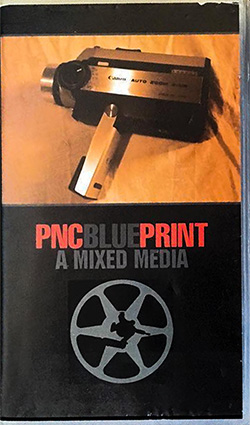 Looking back, everyone was chipping in. Ewan Bowman filmed some of my stuff and I filmed him. He was living at my house at the time so they were local missions where we would take it turns.
Looking back, everyone was chipping in. Ewan Bowman filmed some of my stuff and I filmed him. He was living at my house at the time so they were local missions where we would take it turns.
Marshall Taylor filmed some of that video. My memory is murky of who filmed what. I don’t know how Ewan and I even had a camera. At that moment, it was in no way particular what you had to film with or even how it necessarily looked. Everyone was just putting the time in.
But at the point I was already pretty comfy filming because we had done all these Croydon videos. I think we made three of them. For A Mixed Media, we were just out there doing it, excited to get something.
That’s the year you stepped it up. I remember you winning the St Alban’s comp with the whole run and kickflip to fifty. You always had the ability to turn it on when other people were around. Those comps were hectic.
I see that a lot with skaters in what I do now in skateboarding. To me, it’s that validation. When you get that from a friend, a sponsor, a mentor it can help you see clearer and you begin to become way more confident. That validation changed something in me, it gave me that confidence and lit the fire to push myself more.
“That validation changed something in me, it gave me that confidence and lit the fire to push myself more.”
You’re naturally quite competitive in a sports situation. Do you think the sporting background from when you were younger helped you mentally in with competition skating?
I don’t really know what happened that day. I won that contest and the weekend after I won the Northampton one. That’s the only time it happened for me where I didn’t have nerves.
Usually, ollieing the fun box is a struggle because my legs are so shaky. I’m not sure playing sports when I was younger helped that, it’s more of an anomaly. It was just how I felt on those days that made it what it was. Never again has that happened. £150 for first place! [laughs]
The next year, Anthems comes out. I spoke to Dan Magee and he voiced that A Mixed Media failed to capture how good everyone was but Anthems was approaching doing so. Things are definitely stepped up a gear in this video.
That part sits as a favourite of mine and Magee did a great job with it. A Mixed Media was a little budget but we all learned from it.
Anthems, with the intro, the music, everything – it was a huge step forward.
Your kickflip into the white wall behind Paternoster Square stands out. It’s mad to see in the offcuts footage that you could have done a tre flip and a nollie flip. Imagine if that spot still existed.
That was an incredible area of town to skate then. Still is. But that spot was gold! Oh man, people would be back nose blunt sliding past the light on that thing today. Colin’s kickflip fifty past the light was so heavy. That day was amazing.

Paul’s unique inside out backside tailslide from a Panic advert from 1996
There’s good, ahead of its time, Fairfield footage stuff too. The inside out front nose/backside noseblunt and front blunt/back tail – you shot a sequence of that one.
That was a fun period, experimenting skating the inside of the ledge. There was so much more I wanted to do but then they were filled in. I shot a still of the backside noseblunt with Oliver Barton later and the back tail was a Panic ad sequence in ’96.
What’s your favourite ledge trick you ever filmed at Fairfield?
Either the back tail inside out or the nollie noseslide inside or the back-to-back lines in Waiting For The World on the two ledges close together.
This is around the time you reportedly did a 21 trick line up and down Fairfield.
It’s funny how that’s even a thing, someone else brought that up too. I’d just skate about, back and forth, so I may have done that but no special memory of it.
Someone had the clicker.
Nah, somebody was counting though, I guess. I don’t know who it was. We would go there and I would start the day by ollieing the planters, one after the other. If I did that, I would just keep going. If there was a 21-trick line it would have had some backside 50-50’s in it, not switch back tails or something.
Watching Matt Pritchard skate the whole length of the place was amazing.
Those were the sessions; they were the moments in that spot’s history where it was so kicking.
“I always like to push people to do what they are capable of and that’s why I think I’ve ended up where I am today…”
Lots of that is thanks to your mum’s hospitality. There was a revolving cast of characters who would come and stay from Pritchard to Cairo [Foster], and Ewan Bowman’s permanent residence, for instance. It was like the extended UK skate scene in Croydon.
Those were the days. I think Ewan lived at my mum’s house for a year and gave her £20 when he left. She still laughs about that now.
My Dad found his bong once and thought we were up to way worse. We were old enough to be doing whatever we wanted at the time but my dad wasn’t happy on that one.
Everyone who rode for Panic and Blueprint at that time would come and stay at my house as well as American visitors.
It seems you’ve always brought about having other people around and that’s pushed you. Like you need people invigorating the session. At the time the energy was immense because of that.
I always like to push people to do what they are capable of and that’s why I think I’ve ended up where I am today.
I love skateboarding, first and foremost. I love watching it and immersing myself in it with my friends. Seeing those friends who I’m close with enjoying it on the level that I do is infectious. A hyped session can be the best thing for everyone and it’s all about that energy you put out there.
“A hyped session can be the best thing for everyone and it’s all about that energy you put out there.”
You and Mark Baines seemed to motivate each other. You were a good partnership.
For sure. Baines was on a high level, he was ahead with his skating. The stuff he was doing was like Rob Selley before that. They were innovators. No one was skating like Baines at that time in the U.K. – even later when he did nollie into 180 switch crook, Rick flip out! I haven’t seen anyone else even do that since.
We would feed off each other and hype each other up, I guess that’s what made us who we were at that time. Colin would also be doing crazy stuff. Look at what he did at St Paul’s chalky ledges. He was on a level none of us were, we did our thing, but he just had it all, power, tech, terrain but he was so under-rated.
Paul’s 411 ‘Rookies’ section filmed exclusively in San Francisco.
Panic ran from 95-97. As it was about to morph into Blueprint, you took a trip to SF that led to your 411 ‘Rookies’ section. Were you out there solo on that trip? Was the mission with John Trippe planned before you left?
I’m trying to remember because I went there twice, very close together. First with Mark Skinner and Lee Stewart, the 411 part must have been when I went back three months later.
I met John Trippe when I was there and ended up staying with him with these guys, Chris Roderick and Fuat from Edinburgh. Small studio. I was sleeping on the floor and then Fuat and Chris were sleeping in the kitchen. John was filming the FIT video [Credo] at the time.
We started filming and he asked if I wanted to film a 411 profile. I asked how long we had, he said two weeks so then we just went at it every day. If you watch it, I’ve pretty much got the same clothes on in every clip.
Unplanned. So it changed your trip?
Completely unplanned but that’s how it happened. He was filming people for FIT and I would join in and get clips. That one came together naturally
“There was no way to see your footage. No email, no rough cut – I’d have had to have been sent a VHS cassette to see it.”
Did you feel the gravitas of filming a 411 part?
Not at all. At the time it felt natural to be out filming and there were things I wanted to do.
Mainly, I remember going to SF and wanting to kickflip 50-50 Hubba Hideout. That turned into me filming with John and then it just happened.
I wanted to tre flip the Gonz gap on that same trip but it didn’t happen. We filmed for two weeks, 411 came out and I had a part in it. There was no way to see your footage. No email, no rough cut – I’d have had to have been sent a VHS cassette to see it.
It’s amazing to be part of the Hubba Hideout legacy. Was that kickflip 50-50 third try?
I think it was fast. Seems now, looking back, that a few people did it around that time too. But there was no real way of knowing who did what. I ate shit once but, yes, it didn’t take very long.
Was that at the start of filming with John or at the end?
I want to say it was kind of at the start. We went there one day and I did all the tricks that same day. I don’t think I went there expecting to try the kickflip 50-50. I did the crooked grind and the back tail, tried the kickflip in, slammed, and then just did it.
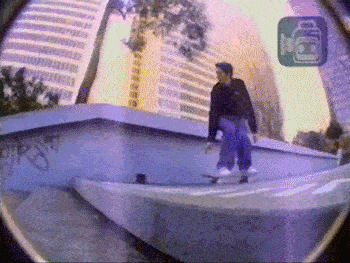
Heavy Hubba Hideout highs taken from Paul’s 411VM Rookies section in Issue #22
For all the Hubba footage in there, it seems a flatground tre flip stole the show…
People seemed to like that one. It haunted me a little because people always expect me to do it like that. Rob Welsh would always ask me to do that tre flip years later.
You were getting DC at a point where they were the elite company. The DC Euro Super tour signalled a change, in my mind, with European interest from a US company. Money was being injected into the team on a level when there was little to no money in UK skateboarding. How were you and Colin Kennedy looked after?
Carl Shipman was a big part of that and he was living in the UK at the time. Outside of him, ‘American’ brands didn’t do anything substantial and it was like that for a long period. You may have ridden for a shoe company, but skaters were making nothing or peanuts compared to someone in the States. There was a great divide which lasted a long time and I want to say it still sits a little like that.
Back then, it seemed to be out of sight and out of mind. If you weren’t in California, your cheque was going to be a lot smaller. In that same vein, I remember when we filmed the Blueprint Build & Destroy promo and 411 denied it. It was meant to be a Blueprint ‘Industry’ section. We never knew why they did, maybe someone knows.
Colin and I were stoked to get the shoes, there was nothing out there like that at the time. We got Droors which was a cool bonus. But as far as making money, we were just some kids in the UK wearing their stuff.
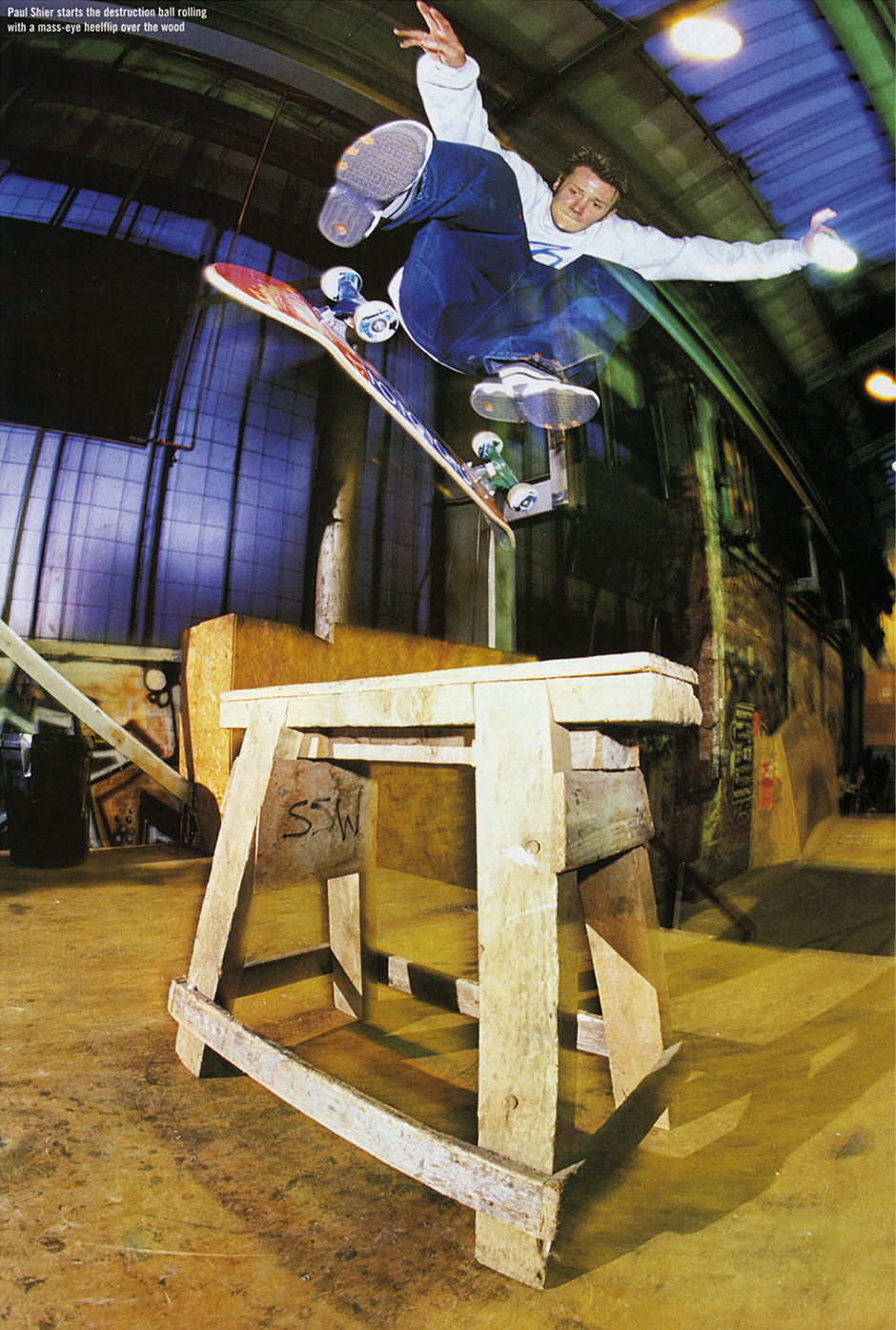
Lesser spotted DC assisted heelflip shot during the ‘Build & Destroy’ era. ph: Andy Horsley
You showed all of us what it meant to be a pro skateboarder. Who did you look to as the benchmark of that?
I looked to who I was next to. Baines and Colin especially, they were so professional with what they did, how they put themselves out there and portrayed themselves.
You can easily kook it, say the wrong thing to someone or act a certain way. The equation isn’t hard. If someone is paying you to skate and you can travel the world, you’ve got to appreciate what you have and put all you have into it. We weren’t paid a lot, but we got to see the world through riding a skateboard.
Baines got on WeSC and we both rode for DVS, Colin was on Savier and Quiksilver. There’s an attitude you’ve got to have if you want to succeed with anything you love. We all still have our hands in skateboarding today while a lot of people we were around don’t
“The equation isn’t hard. If someone is paying you to skate and you can travel the world, you’ve got to appreciate what you have and put all you have into it.”
This is the same time period that you get your first cover and it’s such a memorable one. The ice block crook grind for Sidewalk. Was it a trip to have that come out?
It was. I’ve only ever had two covers. It seems to have turned into this image people think of when they think of me. So many people say it was their first ever Sidewalk. Did people go into WHSmith and buy that magazine because of that cover and start skating, maybe?
I remember going to do it at some ice factory with Wig Worland. They brought these blocks of ice out and, at the time, I thought it was ridiculous. I did some back tails on it, there’s a photo of that somewhere. Then I did a crooked grind and I remember thinking, “A crooked grind, really?”
It seemed so basic. I’m not sure we went there for it to be a cover. Or maybe we did because it was a Christmas issue. We shot it for so long, across two blocks of ice. At first it didn’t look so good but we chiseled the other block of ice which is what’s all around it. We had to do some tinkering to make it look like that, it wasn’t like I had destroyed the ice with the crooked grind.
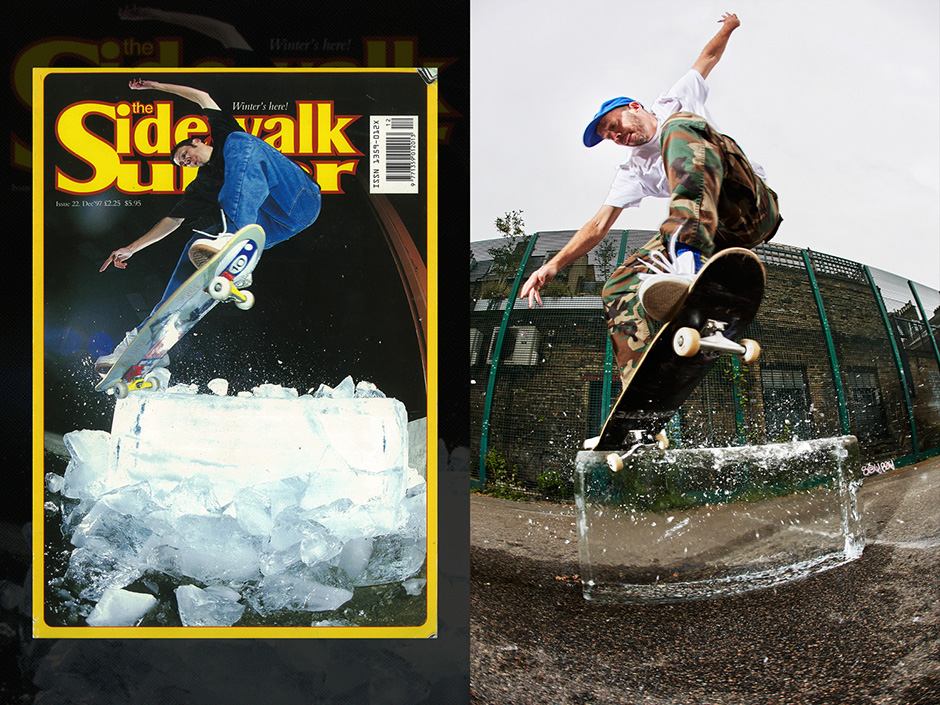
Paul’s iconic Sidewalk cover from 1997 and the remake shot 22 years later. ph: Wig Worland
How did the re-visit come about? Was that a Nick Jensen instigation?
Yeah, Jensen. The original idea, I think he wanted to do a board graphic with it. It was around the time I had my last Isle board so one graphic was going to involve that. But it didn’t end up happening.
I think it was the day after you and I skated in London before the Tyshawn [Jones] event. We went out that night and I skated that block of ice with a heavy hangover. It was terrible.
Everyone was going to show up so we could have this big session but that just turned into me, Tom Knox, Sylvain Tognelli and Remy Taveira.
You know those moments when someone goes away for a summer and comes back on fire? It seems there were quite a few like that for you. From things like the ‘Belong’ tour to trips for different companies, was there a point where you felt your best after having gone somewhere?
I think after I came back from SF, having filmed that ‘Rookies’ part. That was when I feel I had the highest level of confidence. I felt the best on my board and that was down to who I was skating with; skating all day every day and when you do that, you’re going to feel it and progress.
After that trip, you came to Bromley with Baines and ollied this super high bar into a little bank first try. I remember being blown away. There were so many things that you did and never filmed which is unthinkable now. Anything you wish you’d captured?
Only one thing comes to mind: I once 360 flipped a fridge, on its side, from flat at Fairfield.

John Trippe’s footage of the Gonz Gap tre flip at Embarcadero which modified Shier’s approach thereafter
“Definitely no warmup. I don’t think I had even done a tre flip on flat.”
Let’s talk about the one that got away, the Gonz Gap 360 flip. What’s the story there?
I remember being very cocky about doing that to Magee. I remember telling him in the voice we all used to use “Eh, I’m gonna tre flip the Gonz gap tomorrow.”
Full on, check me out, slick back hair thinking I’m the cock of the walk. That night, I had shot a photo with Lance Dawes – a kickflip over a rail and we’d planned to head to Embarcadero the following morning.
Is that the yellow one you ollie in your ‘Rookies’ part at the Moscone centre? There’s John Trippe footage of that as well.
Yeah, the kickflip was in a Thrasher video. I told Lance Dawes that I was going to try it the next day and he said he was down to shoot it. I woke up in the morning, skated to Embarcadero and met all those guys. Magee, John Trippe, Colin was there too. There was a big fence alongside it and down by the side of it. We moved that out of the way.
Definitely no warmup, I don’t think I had even done a tre flip on flat. I just moved the barrier and started trying it. I didn’t ollie it. My mentality was, “Why try ollie it and hurt myself when I could just tre flip it?” Kind of dumb when I think back to it.
“My mentality was, “Why try ollie it and hurt myself when I could just tre flip it?” Kind of dumb when I think back to it.”
I started trying to tre flip it immediately. I probably tried it ten times. The last attempt, where I hurt myself, I was pushing along the run up and some worker guy starts shouting at me about why I moved his fence. I landed primo on my left leg, twisted my ankle and that was it. I walked back to Ewan’s house, bought a 40 oz, a pack of Marlboro Lights and a loaf of Wonder Bread. What a diet, huh? My ankle was massive, I didn’t even ice it, I think. Just put it up on big cushion and laid there. I had walked, like, forty blocks back to his house on it too. I didn’t get a bus or a cab because I didn’t have any money.
They all came back later and got me off the floor. I passed out from a head rush. I woke up in the doorway of the kitchen. Quite the story this, isn’t it? They called an ambulance because they were super worried. The ambulance guys put me in this weird, Hannibal Lecter standing up stretcher because they had to carry me down the stairs. They got me to the hospital and checked out my giant ankle. They did an X-Ray and told me I had a bad sprain, gave me an air-cast and crutches and sent me off. I went back to Ewan’s house. It was Thursday and it was ‘80s night.
“I walked back to Ewan’s house, bought a 40 oz, a pack of Marlboro Lights and a loaf of Wonder Bread. What a diet, huh? My ankle was massive.”
At the Cat Club.
Exactly and this is how dumb I was at the time. We went out to the club, I went on my crutches and got a little drunk. When we left, I was so annoyed with the crutches that I just walked home on it. It was so painful and did no good to it. Then that was it, my trip was done but I stayed there until my flight back rolled around.
I came home and waited for my ankle to feel better, because I was told it was just a sprain, and it never really did. I started going to physical therapist and I had an MRI scan where they discovered a fracture. But at that point I was skating again. I had that lace up ankle brace, there’s footage of me skating in it in First Broadcast, I would just tie my ankle up. Then I had the surgery. That came up in that First Broadcast conversation, why didn’t I have more footage in the video?
“Everything had to change for me. I couldn’t do what I could before on my board. I wasn’t jumping down anything and I haven’t since.”
I didn’t really know the answer. Magee looked at the timeline and there are seven months where I didn’t film one thing. So when First Broadcast was being filmed was when I finally had ankle surgery in England. In the late ‘90s, ankle surgery isn’t what it is today. I asked the doctor if I needed to have physical therapy afterwards and he was like. “Nah, you’ll be alright.”. Which it obviously wouldn’t.
I had to spend the night in the hospital then I just came home, put my foot up, waited for it to feel a little better and started skating again. It was never good again until I had another ankle surgery, two years ago. Now it’s kind of better.
Skateboarding after that fracture, everything had to change for me. I couldn’t do what I could before on my board. I wasn’t jumping down anything and I haven’t since. My outlook had to change for me to continue doing what I was doing. Luckily, I had Fairfield where I could adapt to my surroundings and the ability of my body.
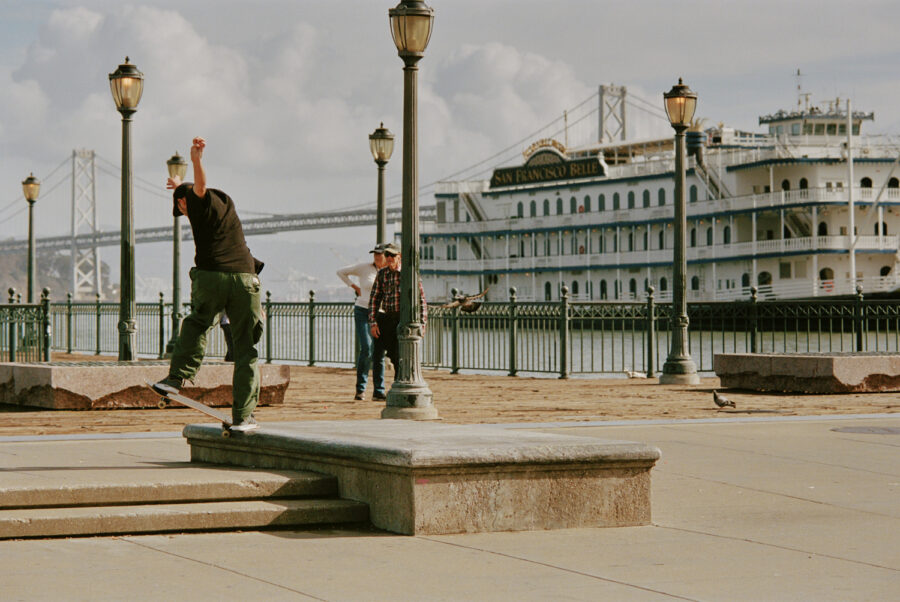
Paul Shier puts his feet on the pad at Pier 7. ph: Zander Taketomo
I was stoked to see your recent footage, skating up the block at Pier 7.
Ah mate, as soon as I saw you could skate there again, I had to get out there.
Thankfully, we had some adidas youngsters from Japan who were there. They were going to be skating the Pier so I took a flight up there for the day. Chico [Brenes] picked me up from the airport and was like “Where do you want to go?”
“Pier 7.”
I always wondered why there was never a line at the Pier in any of your parts. Then Magee surfaced that one with the noseblunt slide. Was it intimidating to skate there?
I never filmed anything there in the daytime. It was very intimidating at that moment.
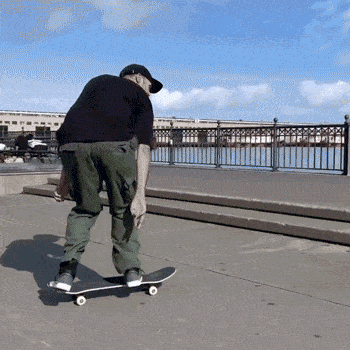
All in a day’s work. Fly to SF, drive from to Pier 7 with Chico Brenes, film some clips, fly back to LA…
“Where do you want to go?”
“Pier 7.”
It seems like that could have been a home away from home.
SF was a home away from home. But at that time cities all over the world had their spots.
London had Southbank, Philly had Love Park, DC had Pulaski and in SF you had Embarcadero and Pier 7. There was an attitude, so just rolling up there was kind of scary. You wouldn’t go there and just try and skate the best you can. That’s just how it was, unfortunately.
That would be the reason I had a line at nighttime. Magee and I wouldn’t have thought about filming there in the day.
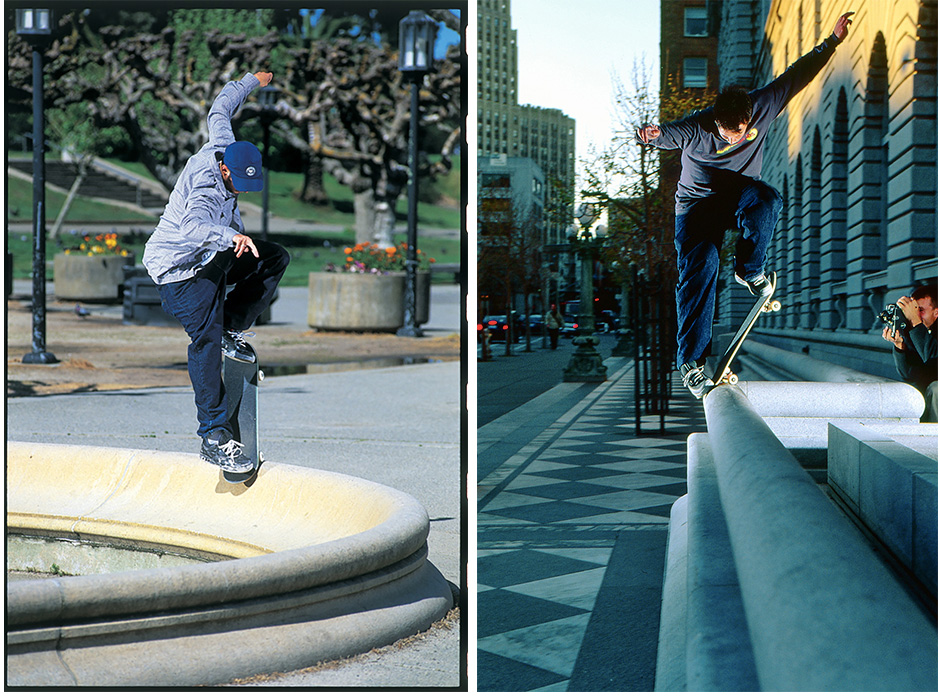
A latter day SF trip harvests two noseblunt transfers. ph: Oliver Barton and Pete Thompson, 2001
Shortly after this is filming for 411 again, essentially, with the ‘Build & Destroy’ promo you mentioned before. This was pitched to go in there anyway and but the edit ended up going in the SUMO video.
Yeah, it was in there, after the video, but yes, as we spoke, it was shut down for 411. [Scott] Palmer killed it in that. Maybe it was too good, just playing. No Magee will maintain they were scared to show this skating from the U.K.
You’ve got the sick backside flip, switch backside flip line behind Shell.
When you’re going to a spot, and you happen to go past a spot that isn’t a spot, then you film something which ends up being a thing… I guess that’s when the best stuff happens, when it’s unexpected.
I loved seeing that raw footage too with Magee calling you a pillock.
He goes off at [Ben] Dominguez for being in the background. At that time, Dan became rally anal about having nothing or nobody in the background. That was the first time I ever experienced that or even thought about it. Someone caring that much, I guess it works and today it’s just the norm.
We were listing some vernacular the other day. Like, “scratch and sniff”, “kebabbing”, “toe dragon”, “kick-down specialist” and so on.
Magee had his ways of getting people to do what he wanted them to do. He used to use the word “stinking” a lot. But it was all pushing people to raise the bar and it worked.
Sometimes he’d do it at the wrong time, I’ve seen him make people cry. But whatever he said to us, he got it back tenfold from the team on trips. It went both ways, it was all fun and games.
Paul Shier’s epic switch backside flip over Westminster Road Gap which ran in Sidewalk. Wig Worland put this video of his photos together so it can live on in a larger format than it’s original, postage stamp-sized form.
Around that time, you also switch backside flipped the Westminster Road Gap. Why was there no footage?
There was just no filmer. I shot a sequence with Wig. At that time there wasn’t this importance to having a filmer on every session.
Wig hit me up because he wanted to shoot a sequence so I suggested we shoot that. I ended up smashing his face a little when we were shooting that. It wasn’t that easy to do, and it took a while. My board hit the street gap at one point, bounced off the inside of the curb and right back at his face. He got this weird lump in his jaw.
To my complete surprise I did it and I was riding away, thinking “That’s it then.” There are some people out there who still doubt me on that one.
The pressure of shooting on film too…
Oh yeah, that too. I don’t think there was ever even any discussion about why that wasn’t filmed with Magee either. I remember when the sequence came out, it was tiny.
“I was riding away, thinking “That’s it then.” There are some people out there who still doubt me on that one.”
Let’s take a moment to romanticise and reminisce over Fairfield Halls some more. Would you say it was like a UK mirror of what was happening at places like Love Park or Embarcadero?
I guess that would have been Southbank, as far as London’s concerned. There were scenes like Fairfield all over the country. With what we had, it was only the dudes who rode for Blueprint or Panic that coming there outside the locals, adding to that scene and pushing that progression.
But it was a “plaza scene”.
It definitely was a plaza scene, we were shitheads to new people who came down. We had that mentality.
I’m not sure I’d compare it to anything else, it was what it was by itself. Were we trying to emulate something we had seen somewhere else? I don’t know. We were just being young.

Fairfield Halls alight at night shot from above by local lensman Dominic Marley.
It came with everything else. Some real characters, some dicey situations and an energy it’s just hard to find elsewhere.
There was never a dull moment in that three-year period of our lives. At that point, we were all just experimenting and experiencing. But those few years there will live forever as some of my fondest memories.
Could you name a few heads and their respective signature moves just to make some peoples’ day?
Mark Skinner’s pop shove to mute grab comes to mind immediately. Peter Hunt’s one foots. Peter Lee’s smooth style. Ray Man’s airwalks. Lee Stewart had many tricks…
Lee did banging melons.
That’s where I go in my head. I was just about to say, banging melon.
I bet Lee could still melon to fakie above your head out of a mini ramp.
So good. Neil Graham, slappy nose. Joe Bloggs just for being called Joe Bloggs. Glen Goddenho, front nose. Rob Lancaster, front heels. Colin Dawson had a good melon too. Ian Anderson did massive nollies. Barrington had a mean back tail and nollie flip. So many, and a whole other era of people after that. Dominguez slamming everywhere, so funny.
“There was never a dull moment in that three-year period of our lives… Those few years there will live forever as some of my fondest memories.”
At the tail end of Fairfield as we know it, the spot was thrashed. Were you stoked to see Dom Henry get some last blasts there as someone who was very much influenced by what you did there.
I was, mate. It’s funny, I’d always have to go there when I went back to England and at the end it was insane how anyone could do anything there. Those cracks were a joke and they’d filled in some of those slabs with tarmac or something. It was terrible.
The last time I went there, I think they got rid of it about three weeks later. There’s an energy that Fairfield holds for me though. However shit it was or hard to skate, it still made you want to skate and have that feeling you used to have. Dom Henry smashed it though because those ledges are not easy grind. They’ll stick on you.
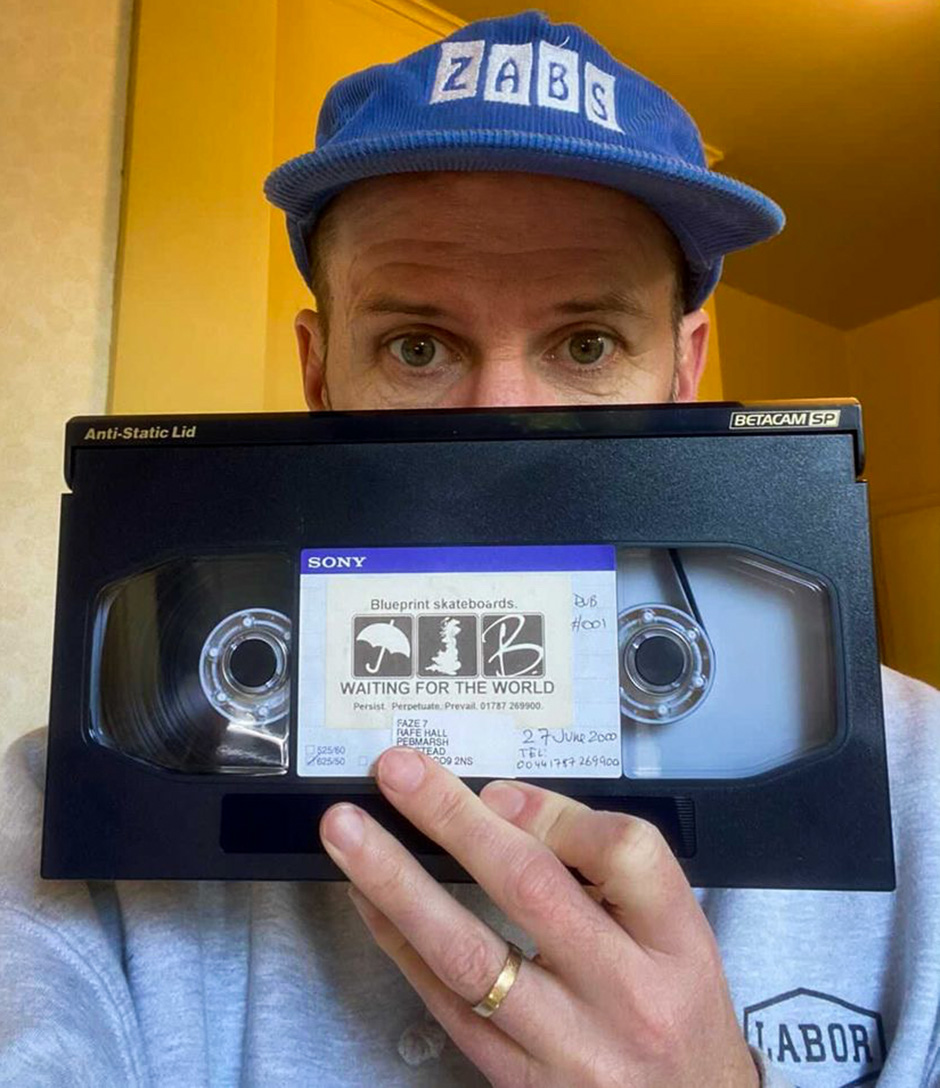
Shier with the master copy of Waiting For The World, the video which changed everything
‘Build & Destroy’ led to making Waiting For The World. Describe the magic of working on it.
It was coming back to skating again after my ankle surgery so it wasn’t the easiest for me.
Personally, when I look back on it, it’s not one of my best parts but the energy around us filming it was just incredible. That was the moment we were just talking about, with those three years of time at Fairfield and skating in town too. Such a crew and at the time we didn’t know Magee’s vision and his skill to make that a reality.
Or what it was going to be. We only knew that on the night of the premiere in Sheffield. Nobody had seen the video or knew what music they were going to have. Nothing. When that was done and we’d seen it, it changed everything. The company and who we were. It gave us the confidence and lifted us up as skaters to do better.
Was there a moment where you knew that video was going to make an impact?
At that point, still, you were just with your mates. You were filming something but with no expectation for it to be different from anything you’d done before.
We had no knowledge outside of anything we had done on the day. No idea of what Magee was thinking. We were just out there, doing the tricks. We have a lot to thank him for, for what he did for all of us, especially with that video. It turned a lot of heads and surprised a lot of people that something like that was made in the UK at that time.
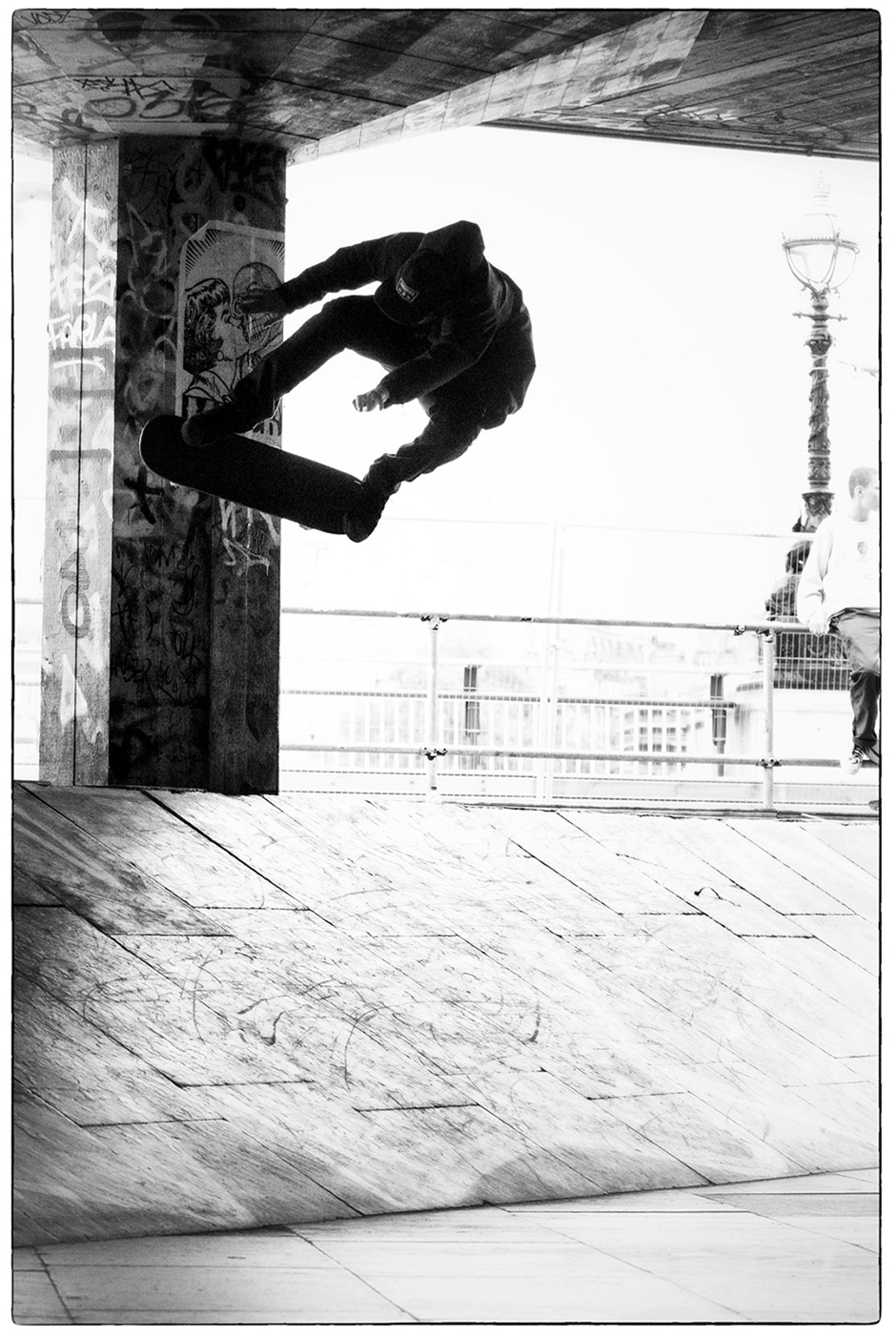
Paul nollies out of a lofty wallride on one of Southbank’s pillars. ph: Andy Horsley
To the point where was taken seriously elsewhere. I guess the prior rejection of the promo lit the fire in Dan even more so, maybe.
I think so because that had a spark of what we did and what he did with WFTW. It was just a moment in time where everything was shining and it put a huge spotlight on UK skateboarding.
It’s a video people still talk about today where skate shops in the middle of America even got a few copies. I had no idea how people even saw it outside of the UK but Dan had the foresight to make NTSC copies of the VHS.
You hurt yourself in the middle of that video.
I fractured my hip on that one too, the slam at the start where I fall into a fence. I chipped a huge piece out of my hip bone.
You weren’t even skating that thing that night either.
No, I was trying to show off.
Baines was trying to kickflip that fence and he wasn’t really trying it. I said “give me your board” and went to ollie it. I got stuck in the plastic grate at the top though and Superman’d into it.
That was one of the most painful things ever so I was off for a while with that too. It was the hip which slowed my footage down in that video and the ankle for the next video [First Broadcast]. I remember being in pain for a lot of the WFTW footage. I kickflip over a bench off some stairs in the city and I remember thinking it was below par because it felt so basic. But also being in loads of pain doing just that.
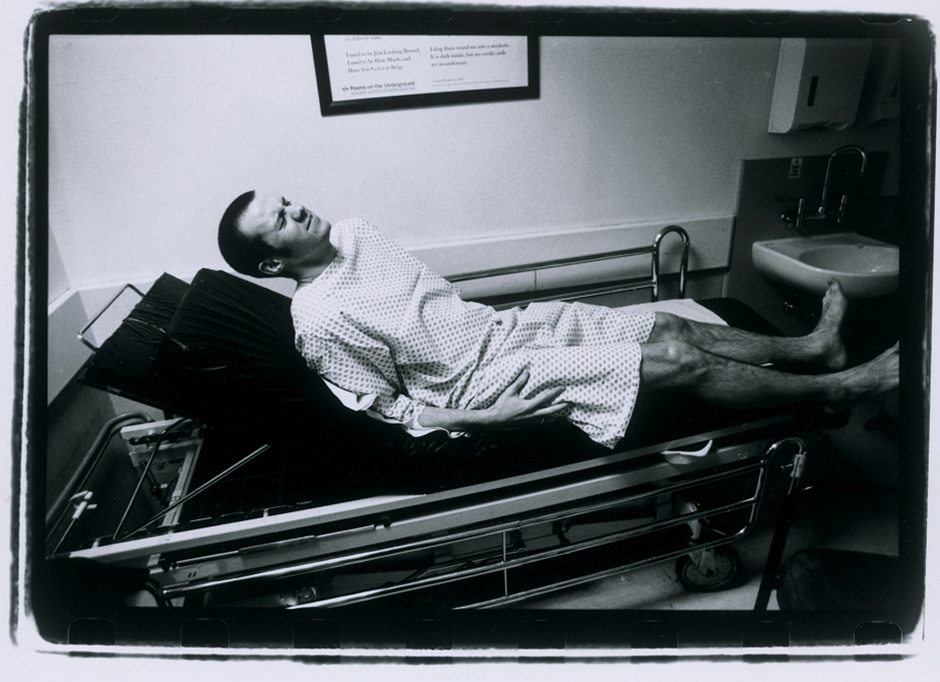
Waiting For The Hip To Heal. ph: Oliver Barton
WFTW raised the visibility of the company, as did First Broadcast. From five in a Travelodge to hanging out with huskies in Finland…
It never changed from five in a Travelodge.
That husky experience happened through Magee’s contact with a company called Mic-Mac. He’d do these jobs for them and we would jump on those and be a part of these shoots which seemed so ridiculous.
He’d do commercials for a Finnish video magazine. They would rent us a big house in the middle of Finland, in wintertime, and we were just left to our own devices and go back to their houses in the city. Then they made a crazy, mini mega ramp on a gap on an iced over lake.
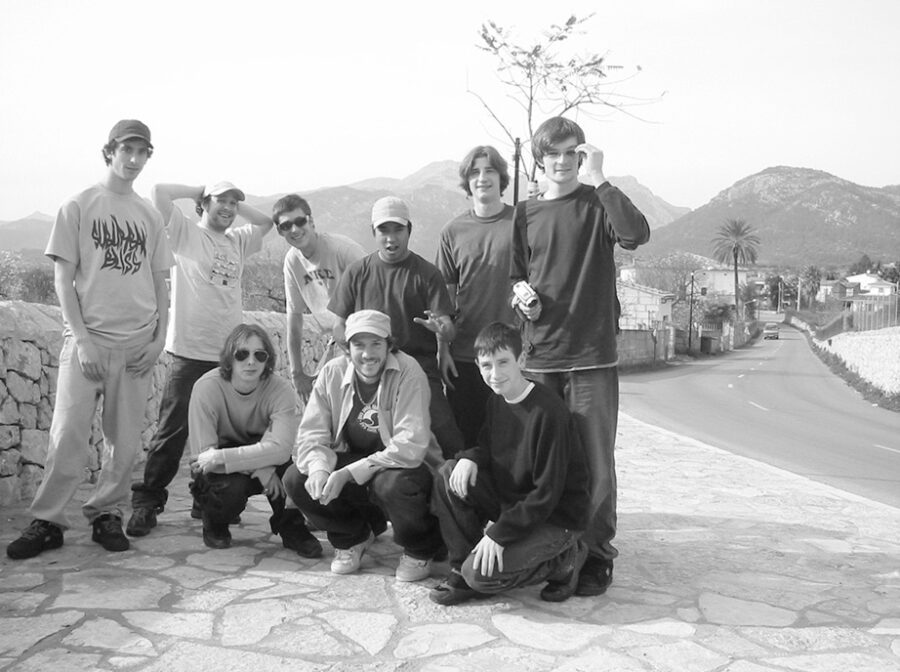
The first Blueprint excursion to Mallorca. Left to right: Toby Shuall, Jacob Sawyer, Mark Baines, Oliver Barton, Paul Shier, Dan Magee, Joey Pressey, Danny Brady, Colin Kennedy. ph: Oliver Barton
Lost and Found is focused on covering more of the country, Europe and you got a Ford Galaxy to for UK trips. Was that the point where there was more financial freedom?
That video features more of England and more of Europe, lots of Spain.
I don’t think we had more money. Most trips weren’t paid for by Blueprint. Dan would pay for stuff himself. By that point I was being paid by DVS with Baines, Colin was paid by Savier, Vaughan was paid by Emerica and people had clothing companies paying them too.
That was how we ended up being able to travel, those companies would give you a budget if you had a plan and asked them to pay for something. Sometimes Joe Burlo would sort the hotels, or we would all chip in together to get something. It’s not like we suddenly had more budget. We were just being paid money and using our own to benefit what we were doing.
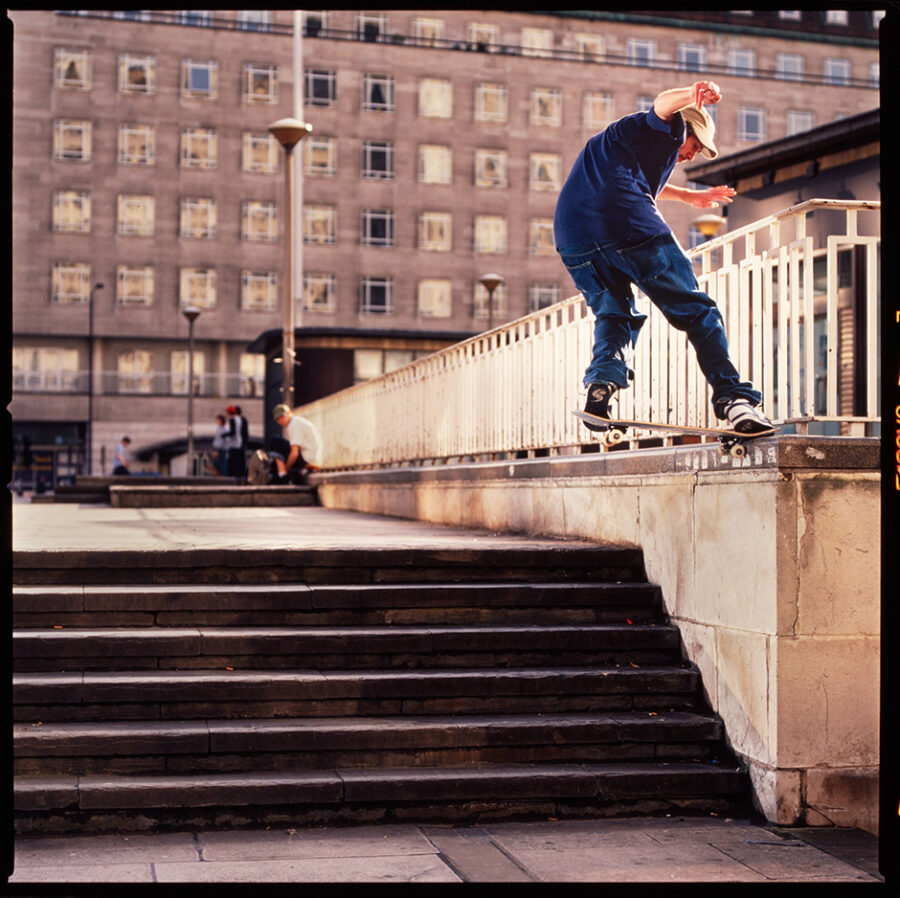
Paul frontside noseslides some under appreciated Shell Centre marble. PH: Wig Worland
It was rad hearing you all together talking about First Broadcast for Grey. Your part has the noseslide pop over in Barcelona. Is that at the point which you’d moved there or maybe the trip when you decided to?
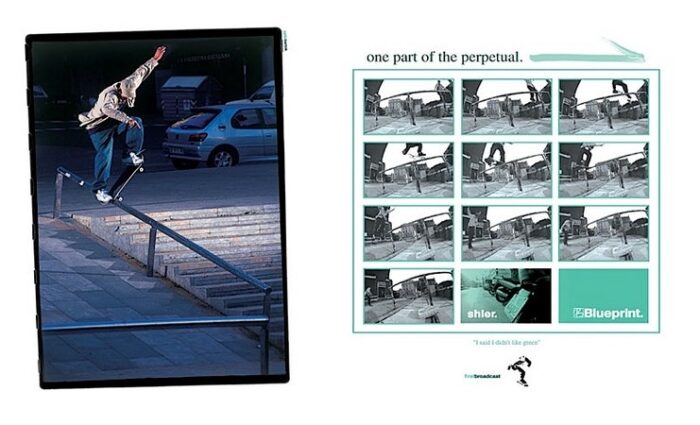 I’m trying to think what shoes I’m wearing because that will give me an idea of when it was. I was transitioning to DVS. I’m sure I’m wearing iPaths in First Broadcast.
I’m trying to think what shoes I’m wearing because that will give me an idea of when it was. I was transitioning to DVS. I’m sure I’m wearing iPaths in First Broadcast.
There’s lots of footage of you skating in iPath Cats in Baines’ video, Driving South.
Right. That’s the same time period because I was trying to get on iPath by just wearing them. Even though I was still on DC but then I ended up getting on DVS. Weird, backwards shit.
That nose slide pop over was on a New Deal trip to Barcelona, just to go there because I knew those dudes. I stayed with Jack Saback, Ricky Oyola and Kenny Reed. That was the first time I ever went to Barcelona.
I went on one trip and then went back there soon after with Kenny for a month which was the start of that journey, at that time everybody came out and stayed with us in the 2 bedroom, it was pretty wild. After that we went back to where we lived, he had a girlfriend and I had a girlfriend. He went back there soon after and moved in with Tony Cox and Jerry Hsu, before I knew it I was on their living room floor and found myself in Spain for 3 years after that.
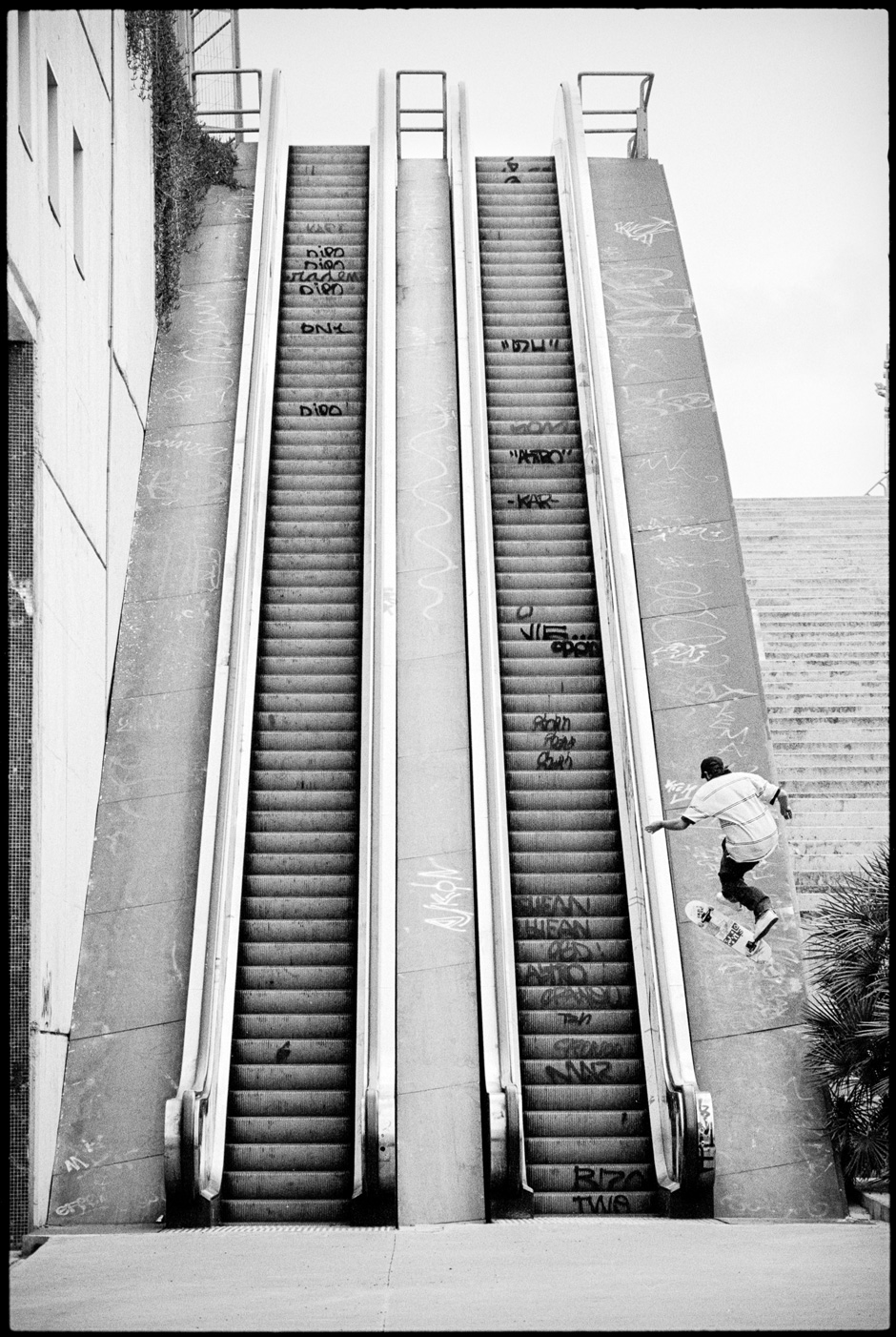
Trainline missions would unearth some gems. Static II era 360 flip. ph: Sam Ashley
It was unexplored at that point right? Macba was unwaxed.
Nobody was at Macba. Everyone skated Sants, that was the spot. It seemed super sketchy around the museum. It was super dark, all so new, the whole thing. We would just get on the train and explore the city, coming up on spots that had maybe been skated once ever.
Skiving the cold winters.
“We skive on cold winters”, yep. It was an interesting way to live for three years. I think my rent was €250 a month, it ended up being free to drink at Manolo because we went there so much. We would, however, eat terribly due to funds but I wouldn’t change the way we did it for anything.
Following your mum’s house in Croydon, the Barcelona apartments became the new crash pad for everybody.
Every week there was a new group of people, it felt like every day there was something going on. We found a way to celebrate a first day, a last day, a birthday, a Wednesday, that’s how we did it. I think everyone who came had a good time.
Things like the Belong tour kept you moving in the UK during that period too.
Yeah, I would fly back and do that alongside coming back to see family.
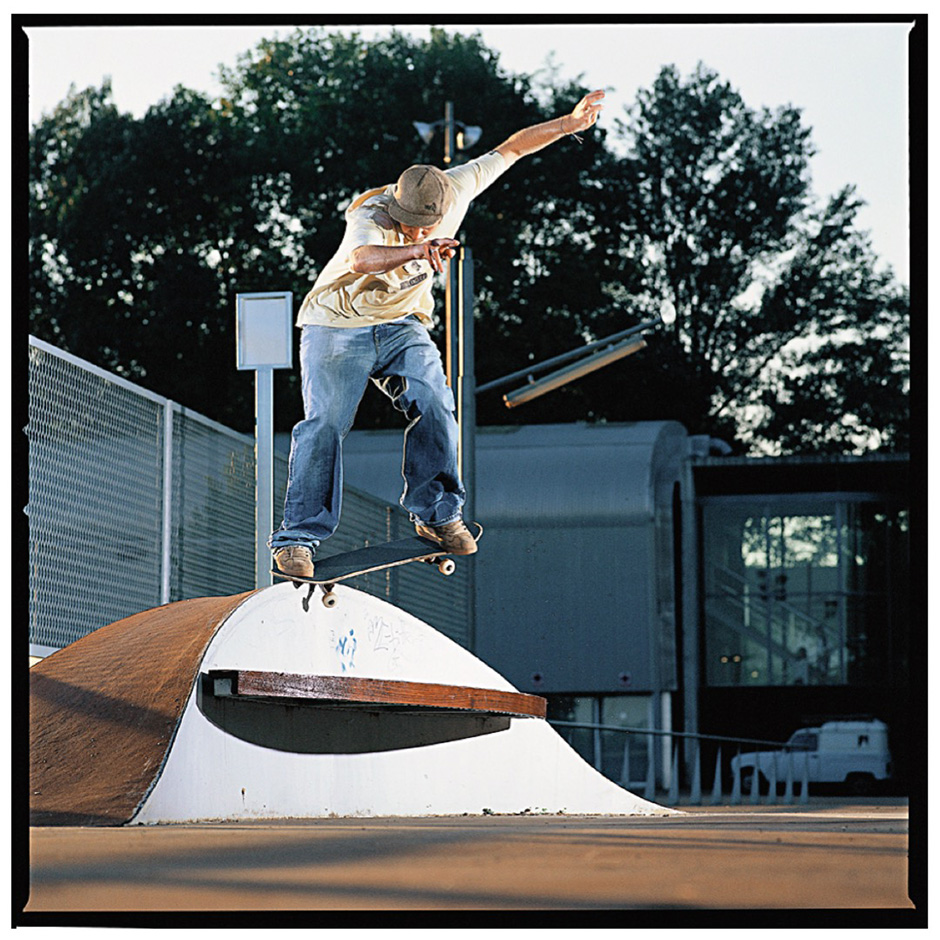
Barcelona based crooked rollercoaster captured by his housemate. ph: Oliver Barton
With that as a base, and living with Kenny Reed, you got the bug for some serious globetrotting. You guys were always off somewhere especially when Static II entered the picture.
Even before Static II we went to Thailand for a 411 ‘Around The World’. It just seemed great what he was doing. He would travel all over the place. Russia, Thailand, Bulgaria, the Stans… ‘The Traveler’! [laughs]. I remember he went to Papa New Guinea by himself to stay with a tribe and came back with insane footage. He lived for the experience.
Once I started traveling a lot, I was in. It was always just, like, “Yep, let’s go!” It’s something you can’t beat. I’m so grateful for, and fortunate to have had, that in my life. Anyone who gets paid to skate or paid to travel should take advantage of that as it’s not going to be like that forever. I enjoy it when I see skaters like Kevin White who live for that experience of travel, people and skateboarding. If you can, go see the world. It’s an education.
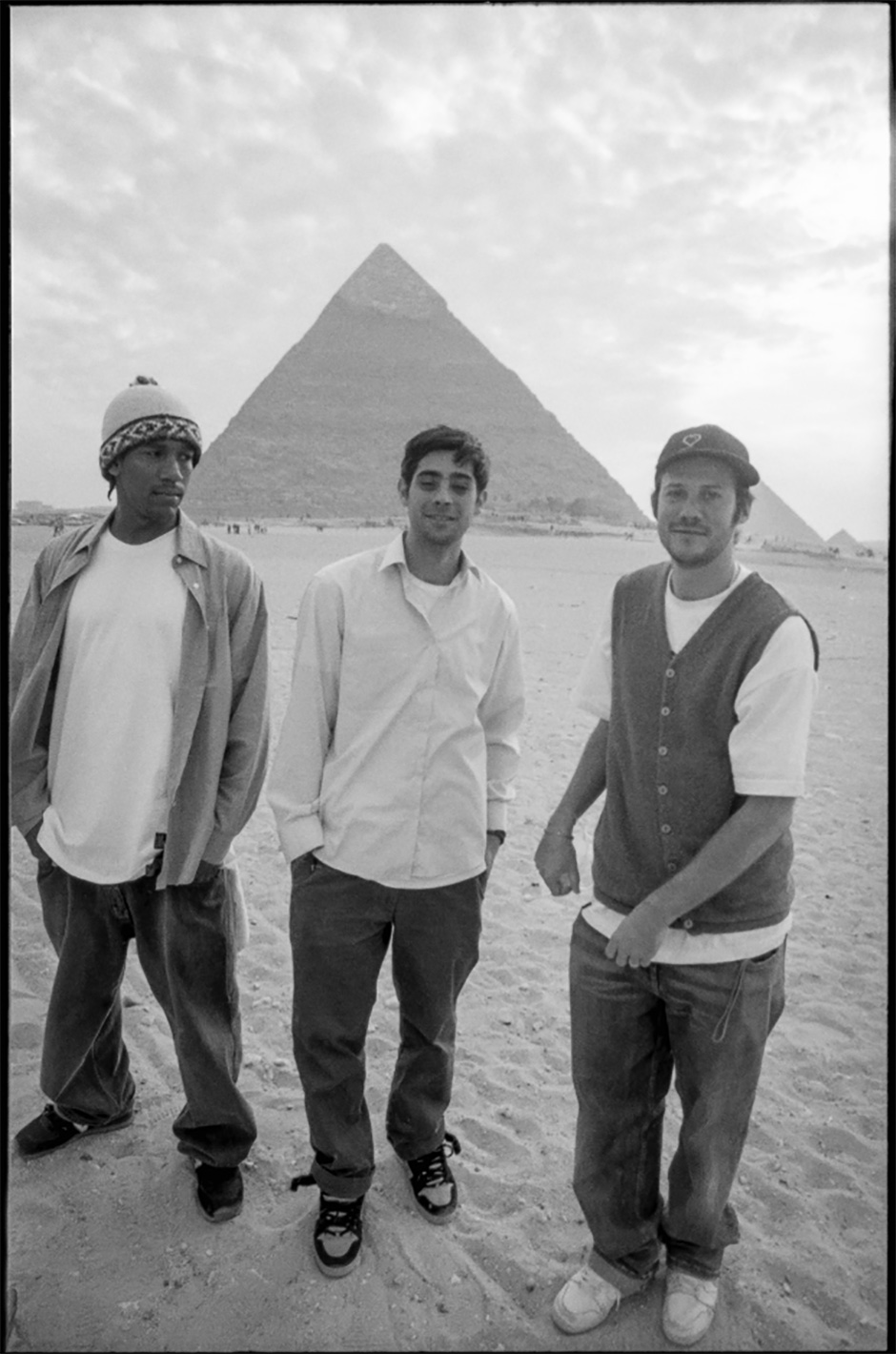
Kenny Hughes, Kenny Reed and Paul Shier, Pyramids of Giza / Below: crooked grind transfer at the matches in Montbau while filming for Static II. photos: Josh Stewart
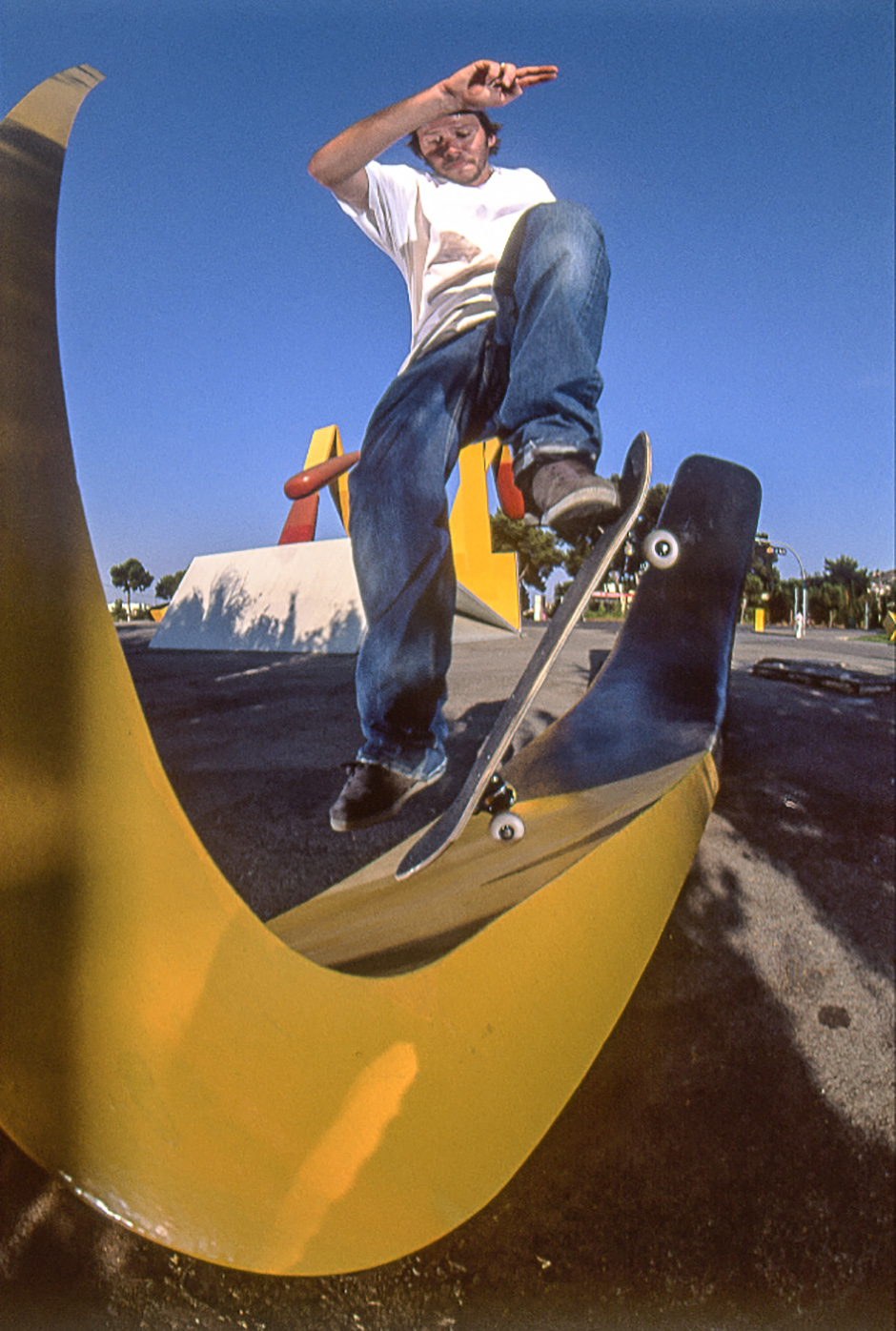 What was the craziest experience from the Static II timeframe? How long was that in progress?
What was the craziest experience from the Static II timeframe? How long was that in progress?
Two years, I think. It came from nowhere. I didn’t even know Josh [Stewart] at the time.
Kenny was already filming a part and Josh was going to London. Josh asked Kenny who would be up to film in London, Kenny said my name and I met up with him. We filmed one line at Southbank and he decided he wanted to do a video part with me.
Filming in Transylvania was a trip, for sure. It’s crazy where skateboarding can take you sometimes.
No wi-fi.
No wi-fi, no phones, nothing.
I remember Dom Marley booked the trip too. The place we were staying was an out of season ski lodge and we were out there. Yaks, carts, dirt roads.
Static II was followed by Lost and Found. You’ve said this was the most fun video that you filmed for?
Yeah, Lost and Found was super fun but it was also the one video part where it felt like a job. I’m saying that because Lost and Found was filmed mostly when I was very much into the night life of Barcelona.
Late nights, later mornings – I would sleep in so late. Then I would be, “Okay, we’re getting on the train, going to this spot, to film this trick.” When that’s done, I’d go back home.
No warmup, no session, just the mission. I had a different mentality working for that. Waiting For the World or A Mixed Media were a byproduct of what we were doing at the time. With Lost and Found, I knew what I wanted to put out and what I wanted it to look like, trick-wise.
“Waiting For the World or A Mixed Media were a byproduct of what we were doing at the time. With Lost and Found, I knew what I wanted to put out and what I wanted it to look like, trick-wise.”
You were surrounded by friends who would all be going to Paral-lel and Macba for the day and you’d be breaking out on specific solo missions.
Yeah, I was. Maybe that was the moment for me where I figured, “Right, I’m going to go and skate this other shit. Go out there and find something. Don’t take the easy, mundane route.”
And from your missions with Josh Stewart preceding that video –
We would mostly take the train to the very last stops in Barcelona and just skate home, seeing what we could find along the way.
That’s how we found many of the spots that would be in Static II or Lost and Found. It feels like I was working on both video parts concurrently.
Lost and Found has one of my favourite Fairfield clips: the ollie up-backside flip-switch manny.
That was a hard one. Why I chose to do it at night too seems silly now.
The tre flip to fakie around the bench on that metal bank in BCN was amazing. That doesn’t necessarily translate to how treacherous that was.
When I talk about skateboarding feeling like a job at that time, that’s where I think about it.
We skated to the spot from my apartment, did it, and then just left and went home. Magee said recently he was going to make a little thing about that on his @meetatbenjys account. I don’t really remember how many tries it took to do it so I’d be stoked to see that.
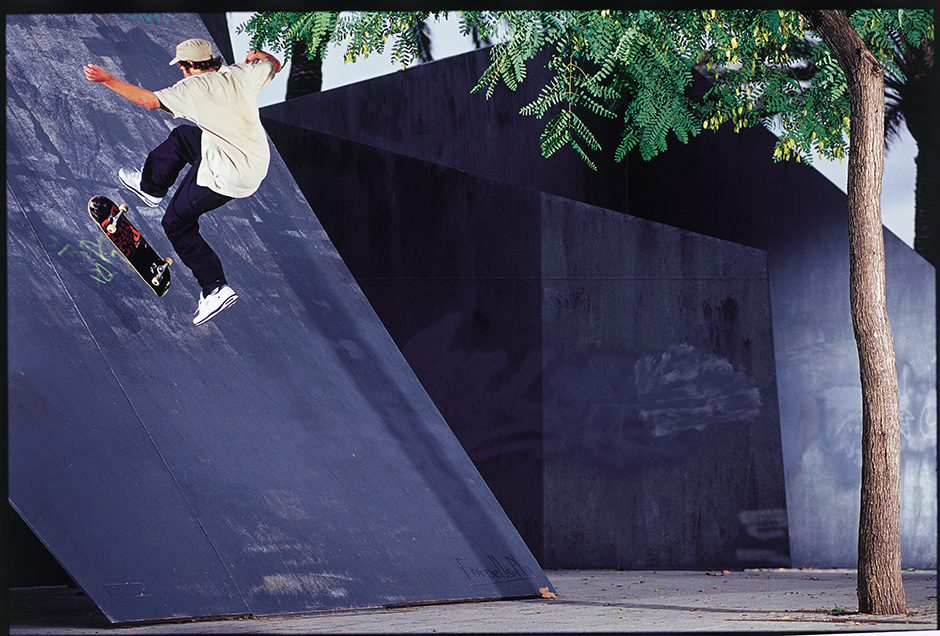
360 flip to fakie before the bench addition which would create Paul’s Lost and Found ender. ph: Oliver Barton
Was it a saga?
Mentally challenging, at first. I had to block the bench out and believe how easy it would be to do a tre flip without it being there. Visualisation played a big part.
For a long time there was no bench. That was put there as a skate stopper. Edson did a trick on it the same day I did, a big spin – I think. Like a frontside shove to fakie. It was sick. Magee would have that footage.
I hadn’t seen that spot for a while until a SOUR edit where Nisse Ingemarsson did a noseslide on the bench and popped over into the bank. So good! Not many things you see these days via the internet get you going but that one did.
Magee has said it was a conscious effort with Lost and Found to include a broad spectrum of spots around the UK which just wasn’t possible before, logistically. The videos which predate it were largely London-centric by necessity.
I really didn’t spend too much time outside of London before a certain time. Only when I met Colin and Baines would I start going to visit Glasgow, Edinburgh, and Sheffield. I didn’t know anyone there before that so I wasn’t ever planning to visit these places.
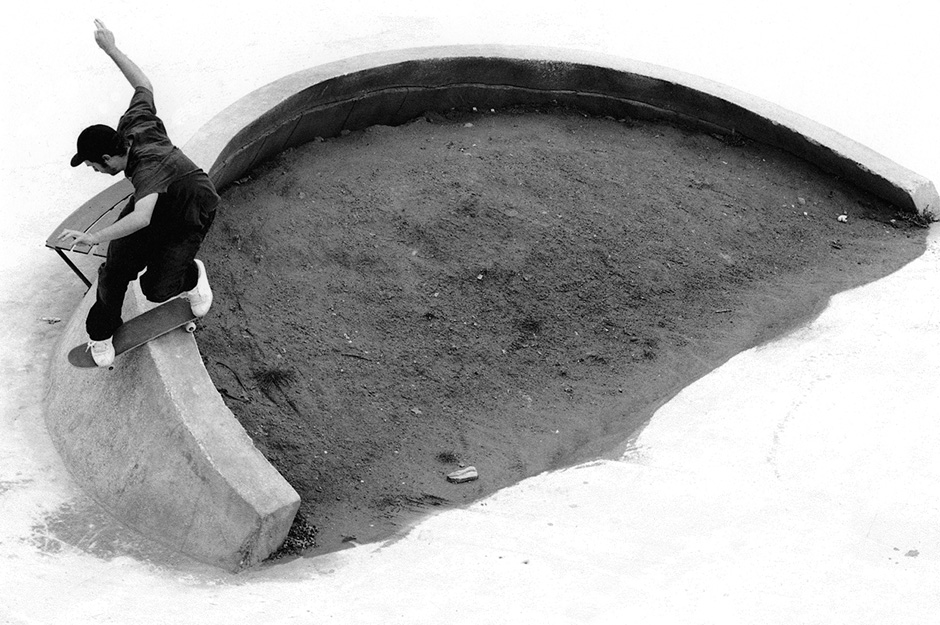
Paul’s second ever cover photo. Lost and Found-era backside lipslide for Sidewalk Magazine #98, November 2004. ph: Andy Horsley
DVS’ Dudes Dudes Dudes would be the video afterwards which is a good time stamp as it’s a product of a lot of trips.
There were a lot for that and that was on another budget. That their first video where European riders were featured on a global level. Myself, Brophy, Baines, Lucien [Clarke], Kristian Bomholt, Janne Saario – we got to travel a lot on that one.
That’s more beneficial than anything to me, it’s priceless. It was a fun one because I got to work with Colin Kennedy [the American, not Paul’s former Bluprint teammate] and Cole Matthews. I had no idea I was even having a part in it until Cole started editing. He hit me up and said, “What music you want?”
“For what?”’
“Your part!”
I was nervous on that one. At the time, I didn’t feel good on my board.
How does that fit into you meeting your wife in Barcelona and moving to Los Angeles?
It would have been the same point because they had a premiere for the video at The Berrics and I was here for it. I have tricks in the video I filmed here like the front nose pop over on the bridge which is the last trick. The tours to Europe were all from here as a base.
Make Friends With The Colour Blue is next. That’s probably my favourite part of yours because you’re skating everything and it’s shot all over the place. It’s a well rounded one.
I worked the hardest for Make Friends. At the time, that was going to be it. My last one. I put my everything into it.
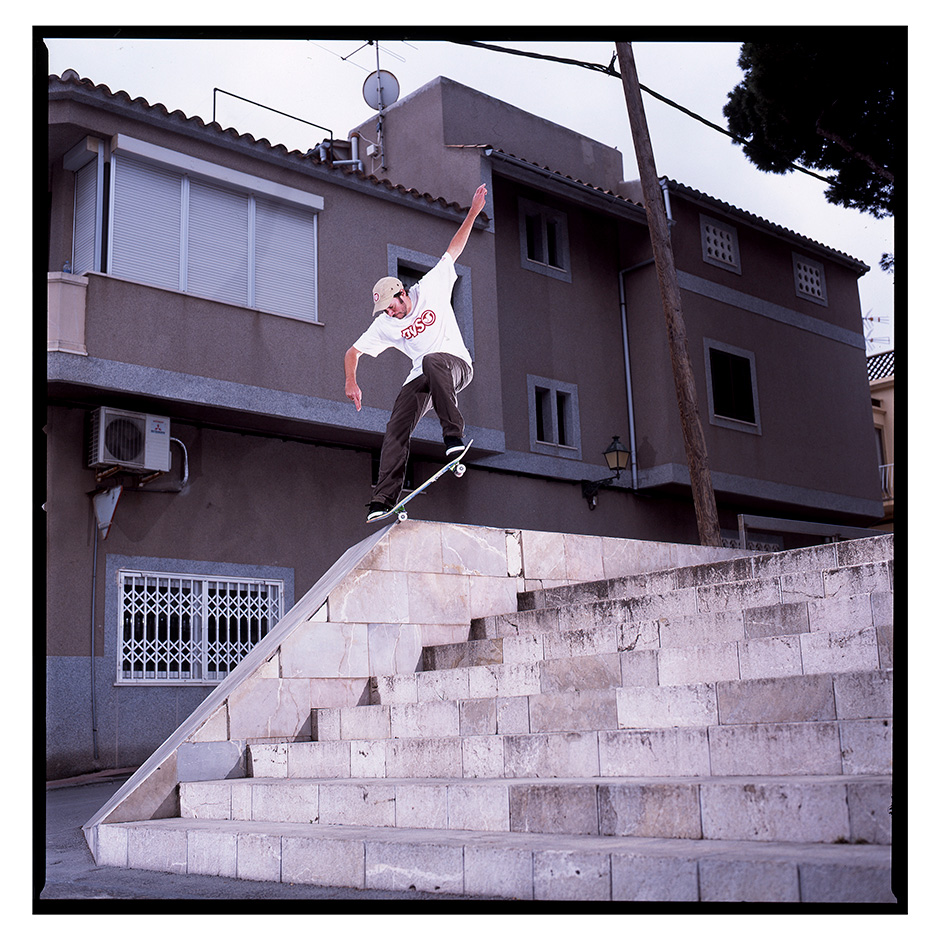
This gnarly crooked grind would be Shier’s ender in Make Friends With The Colour Blue. ph: Leo Sharp
“I worked the hardest for Make Friends. At the time, that was going to be it. My last one. I put my everything into it.”
That was the first Blueprint video to have a US premiere.
It was. It’s funny, I speak to people I work with now and they tell me they went to that premiere. Some of them must have been 12 or something and that was one of their first.
A lot of pain, a lot of fun, a lot of travelling. That was a point where we seemed to be doing alright financially as a company but that it seemed to decline fast.
“It’s unfortunate there isn’t a system in place to help skateboarders transition from being a professional to moving on with their lives after.”
You were team manager, marketing manager and pro at the same time which is the segue into everything which followed. Including doing the same job for DVS.
DVS happened around the same time. Blueprint was already out here when that came up.
We were filming MFWTCB when Joe Burlo – rest in peace, was still the owner. Then Faze 7 went out of business and he had to sell Blueprint. I remember Burlo calling me to say it was done and I was like, “Fuck!”
Then it was a roundabout of places it was going to be sold to. Magee and I were fighting to have a say. We talked about all of that in the previous interview we did. This all coincided with DVS also going out of business. It happened so close together that I went from earning a certain amount to zero in a very short period. I was in a bit of a state about the whole thing and faced with the quick reality of being a pro skateboarder to not.
That’s what happens in skateboarding. I see it every day. It’s unfortunate there isn’t a system in place to help skateboarders transition from being a professional to moving on with their lives after.
DVS got bought by someone else too which is when I got that job with them. I was working for Blueprint, skating for each company, and being TM for both at the same time. There was a lot going on but at that time I was hustling to get by. I remember doing sales for Blueprint, shop to shop, and that wasn’t for me. Kudos to anyone who does that job because it’s tough.
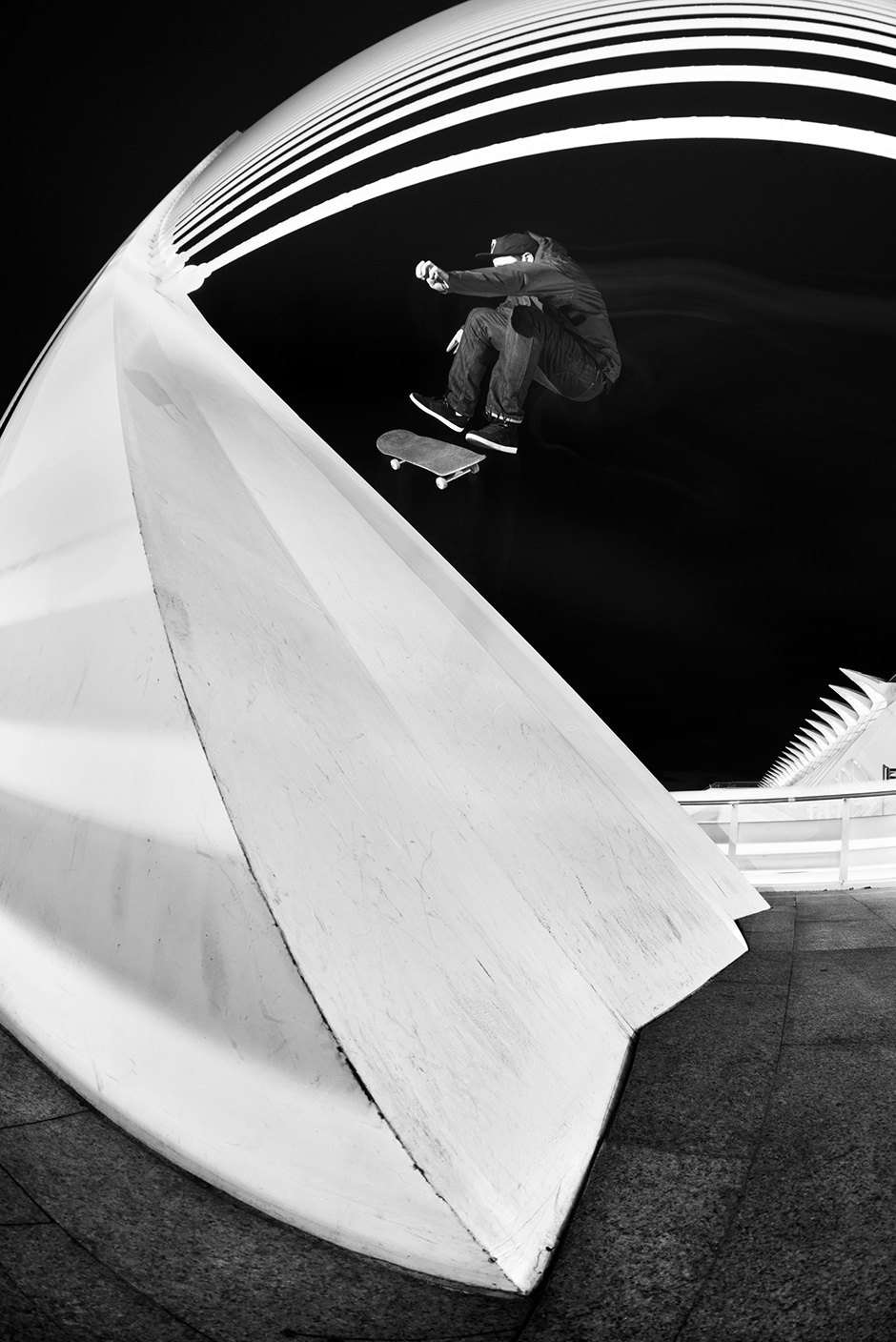
Kickflip to fakie on the steepness in Valencia, the very first Isle trip in 2013. ph: Henry Kingsford / Below: Chris Aylen, Paul Shier, Nick Jensen, Casper Brooker, Jacob Harris and Tom Knox after Isle won Video and Brand Of The Year at BESA, 2016. ph: Farran Golding
Two years after that video, Blueprint came to a close but that signals the beginning of Isle which is nearly ten years deep now. It’s nice that instead of being burned out, you were motivated to create something new. How’ve you found the experience of running a company?
I was highly motivated at the time, very focused. I felt like there had been such a mess up with Blueprint: what it was and what it turned into due to decisions that were made. I didn’t want to be done there. I wanted to create a brand with somebody I was close to and represent people who I loved what they did. There were standards that had to be met with products, design and we wanted to create something special for us. That’s what Blueprint had been and ended up not being.
“Our first trip to Valencia when all we had were these blank boards, a can of spray, and an Isle stencil. The beginning of the journey was a giddy one for sure.”
A chance to be in control rather than being dissatisfied.
Exactly. Once you get to do it, it’s a lot of hard work but it’s yours so you’re so motivated to push it forward and succeed.
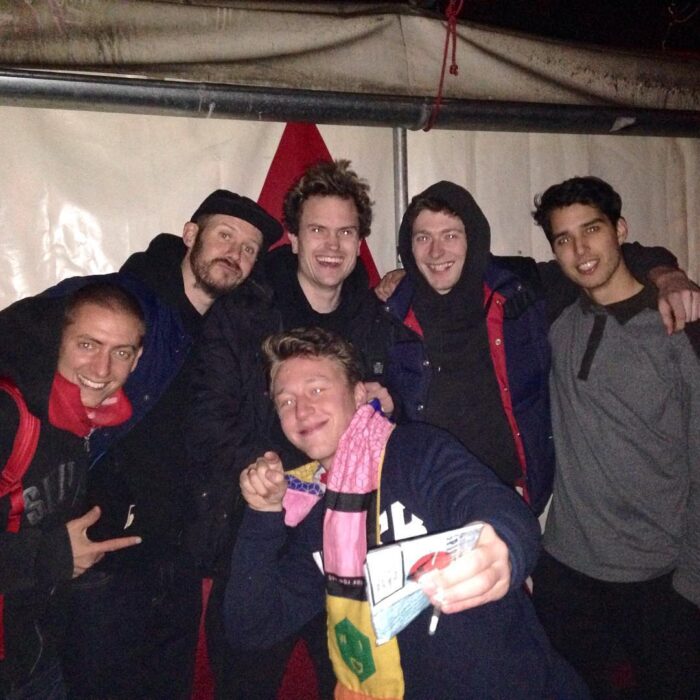 It was so positive and amazing out the gate getting to work with Jensen and Chris Aylen, who was one of the people I was with at Fairfield in the very beginning. He had that design experience, with the work he had done with Crooked Tongues, which was something Nick and I didn’t.
It was so positive and amazing out the gate getting to work with Jensen and Chris Aylen, who was one of the people I was with at Fairfield in the very beginning. He had that design experience, with the work he had done with Crooked Tongues, which was something Nick and I didn’t.
Chris Aylen would be in that Fairfield’s signature move list with a pop shove too.
He would, up the three stairs. He’s in that timeline, for sure.
Once Blueprint was done, I called Nick and Chris. They were both down and we started on our journey. They oversaw design while I was on the back end of production and sales.
What have been some of the high points?
Our first trip to Valencia when all we had were these blank boards, a can of spray, and an Isle stencil. The beginning of the journey was a giddy one for sure.
When the first boards delivered, seeing ideas come to fruition for the first time is amazing. There are so many. The Vase video coming together was pinnacle. Winning brand of the year at the Bright show, that was a messy one! ha-ha! That was a crazy night for me too, in the madness of it all I also got a call to let me know that I got the job at adidas, so it was a crazy night.
Our Carharrt collab with Raphael Zarka was unbelievable to see, so much hard work on that from Nick, Chris, Sylvain and Raphael. Watching the progression of everyone over the years, I’m proud of every single one of them. Mike [Arnold] and what he’s done with adidas, Tom Knox and where he is at with NB# and his beautiful family, everything Casper has achieved. There are so many, and I look forward to creating more.

The first ‘Curiosities’ series of Isle pro boards for Paul Shier, Nick Jensen and Sylvain Tognelli.
What’s going on with Isle now?
With everything, there’s evolution. Nick and I took what we experienced and learned with Blueprint and evolved something new together which we have worked closely on for years. We got our favourite skaters on a team and worked creating how we wanted skateboarding to be represented.
I believe in what we did, helping the team in part of their journey to who they are today. I personally know that it is the skateboarder first who is the workhorse. With the help from their sponsors, they can grow to something much bigger which I have watched with everyone over the past eight years.
Towards the end of last year, there was a team sit down where it came to light that a few people wanted to grow past where they were with Isle and do their own thing. Whilst at the time it came as a shock, I spoke to everybody and respected their decision.
I sat for a week, thought over the good times and in that time never was there a moment when I felt bummed. I fully understood it. That’s skateboarding and its evolution. The news came at a time when I was about to order two seasons of product and I chose to cancel it all in that moment.
“I believe in what we did, helping the team in part of their journey to who they are today. I personally know that it is the skateboarder first who is the workhorse.”
I went back to thinking about my personal motivation of why Isle was started, why was I still doing it and why would I want to keep it going? I spent a lot of time talking to distributors, friends and only received positive feedback about myself, Nick and the brand. After talking long and hard with Nick, we decided right we would keep doing what we love to do, keeping it a small team, continuing to work with great artists and people who want to contribute to creating something new for us going forward.
Nick and I also got help from an old friend, Jan Tomson who is helping us going forward. I was thankful we still had some promo left so I have been able to supply those guys while they transitioned into something new. Nothing but love for them all.
It’s great news that it’s still rolling.
Nick and I love what we do and our mentality hasn’t changed.
Since retiring the pro board yourself, you’ve been skating better than ever. It’s like a new lease of life seeing you out there these days.
That has a lot to do with the ankle surgery I finally had at the beginning of the pandemic. Before that I could skate for an hour and I was done because my ankle hurt so much. I had the surgery and went into a heavy physio program. Then I just started skating by myself because you weren’t supposed to see anyone at that time. I was very focused and interested in getting my ankle back to a better place.
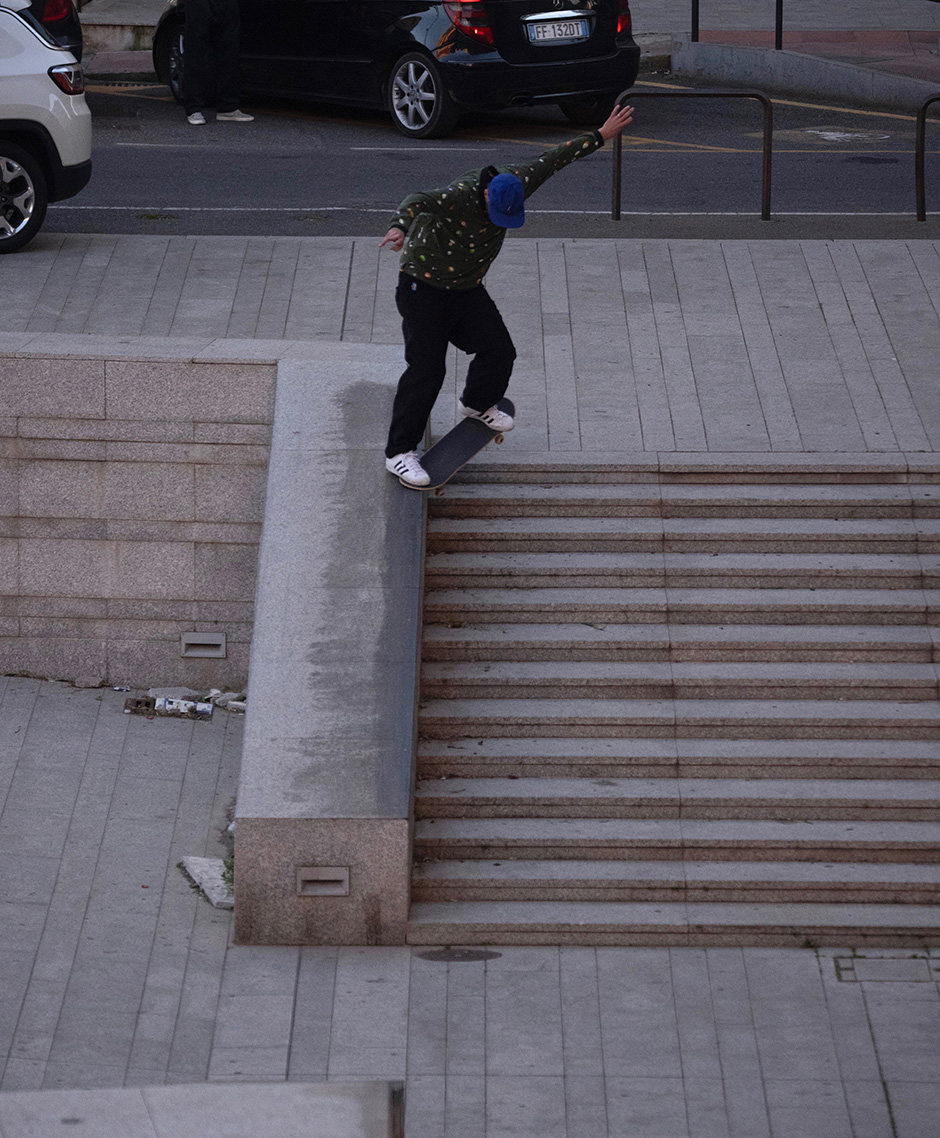
From only being able to skate for an hour to crooked grinding hubbas on a recent trip to Sardinia. ph: Joey Guevara
Back to the beginning. Outside your house, on your own.
It was and I found it again.
I’ve never disliked skating, never gave up, the only time I haven’t skated is when I’ve been hurt. But having this surgery and not being in pain anymore was huge. It gave me a whole new lease on skateboarding life.
I’m so fortunate and grateful that I can still do this. I’m 47, I love skating and I just can’t stop. I was talking to my dad today and he was laughing, asking me if I’d still be skating at 50. I didn’t think I’d be skating now when I was 30 so, probably, yes. It’s so funny that there’s still that time limit in my dad’s mind where skating past 50 is ridiculous.
Tony Hawk, Steve Cab, Tony Alva are still blazing that trail.
You can skate forever if you are good to your body. Thankfully, I realised that not too late. I get that you don’t want to be 60, banging your head on the ground, but it does still feel good to throw yourself onto the concrete.
“You don’t want to be 60, banging your head on the ground, but it does still feel good to throw yourself onto the concrete.”
We’ll be padded up then. Hip pads and everything.
I feel like we will always skate. I was skating the curbs in Santa Monica yesterday and saw many a person, old and young, just riding into the sunset.
It appears you’re always excited to be doing what you do; posting photos of flights like you’ve never lost that childlike wonder of getting to do this thing.
I don’t think I’ll ever lose it. I just got back from Sardinia on the SOTY trip for Mark Suciu and it was incredible. New spots are so special these days, for me and the crew it is with. Life is exciting. I’ve listened to people turning down trips. Not everyone is the same and not everyone wants to travel and leave their home city, it’s a lot more common than you would think. I respect that but that’s not for me. I love what I do and it will never be taken for granted.
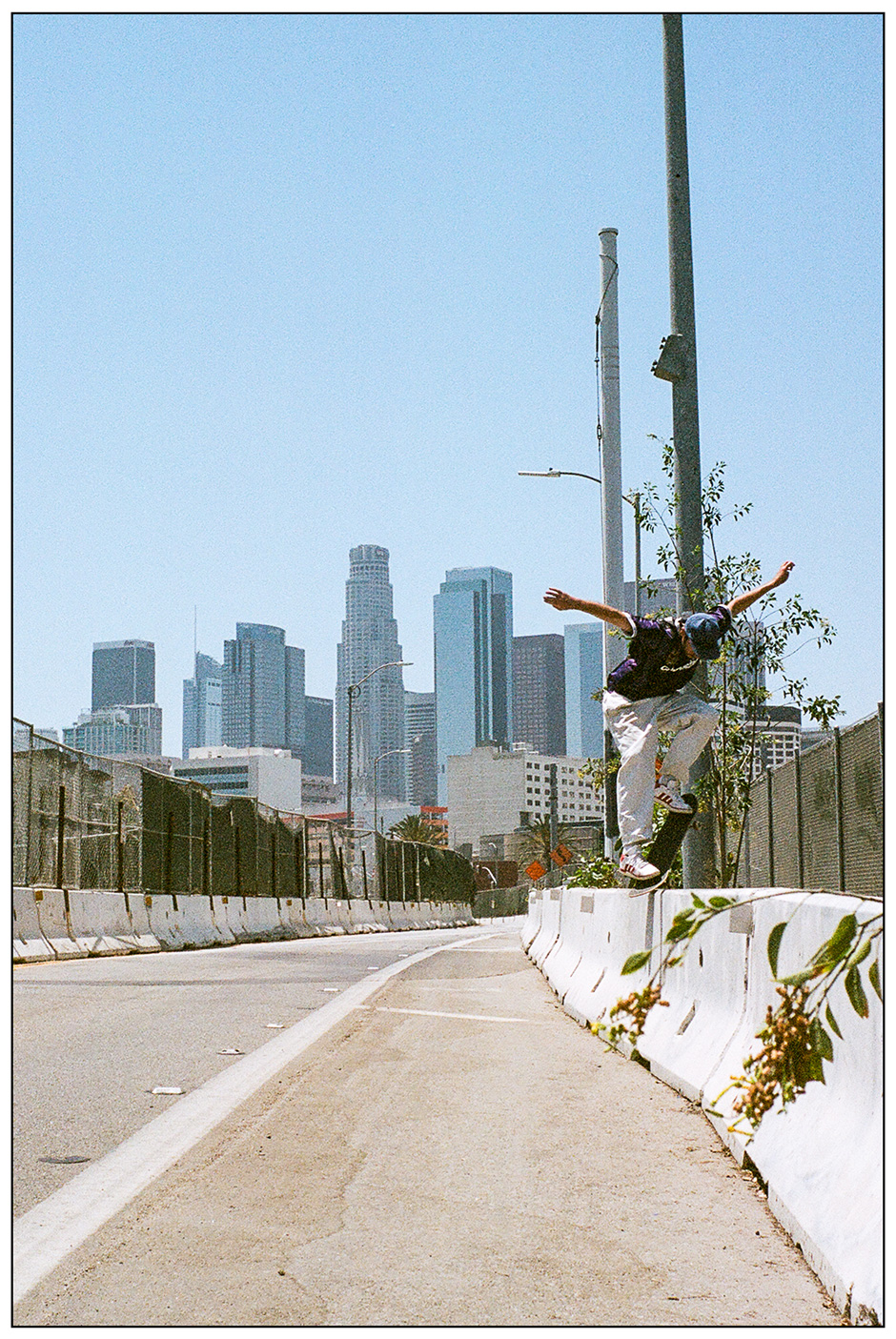
Frontside noseslide pop over just a few months ago. ph: Nestor Judkins
Bar picking up a camera, you’ve literally been there and done it all within skateboarding from working in a skate shop to what you’re doing now. Are you ever involved in shoe design?
Never directly with the actual design but I do work with the team on their shoes regarding colors and fabrics on different seasons. Or if there is a specific team rider colorway we’re focusing on. Bossman Scott Johnston heads up the shoe design team.
It was cool to see you on the panel at Pushing Boarders a little while back. Do you want to be involved in more things like that in the future?
I would love to be more involved in that side of things. I feel like I didn’t say enough, I’m not very confident at public speaking but I’m slowly learning to be better at it.
Huge respect to the work that is put in by people like Nestor Judkins who has his non profit – Salad Days of Skateboarding, Skate like a Girl, Dan Mancina (Actions Realized), Kenny Reed (Skate Quilya), Theo (Skatepal) So many people doing great things in skateboarding now. I look forward to helping in any way I can in the future.

With a new part in progress, Paul kickflips to fakie in a trademark tight spot. ph: Jeremy Adams
Skateboarding seems wide open with growth and inclusivity meaning the Olympics can exist but so can underground videos, scenes and everything in between. How do you feel about where things are at right now?
It’s in the best place it’s ever been. Skateboarding is such a strong space to be in which I don’t feel it always was. The communities and friendships being created and represented are beautiful.
The Olympics side is just the progression of where we are. If skateboarding in a big contest can create more eyes on skateboarding, creating more skateboarders, that can only be a good thing. Also, for the one kid who starts skating to be an Olympic athlete, there will be 50 who don’t.
Personally, being able to work alongside someone like Dan Mancina has been nothing but incredible. Everything he is doing with Actions Realized and how he is putting skateboarding in front of an audience that may have never thought it possible is so inspiring. Watching as adaptive skateboarding becomes more visible is so positive. If this can be a part of Paralympics, that’s incredible.
Companies, mags and organisations making skateboarding stronger – There, Glue, Unity, Skate Like A Girl, Mess – are all such a breath of fresh air and a positive movement in what we are all a part of. The future of skateboarding is in good hands.
Your Instagram output suggests there’s another video part in you. What are you saying?
I have been working on another part, slowly taking my time. I’m not sure what the plan is with it, or if it will ever be a thing. It’s fun working at your own pace though.
Amazing. Any last words?
Enjoy, don’t just let it slip away.
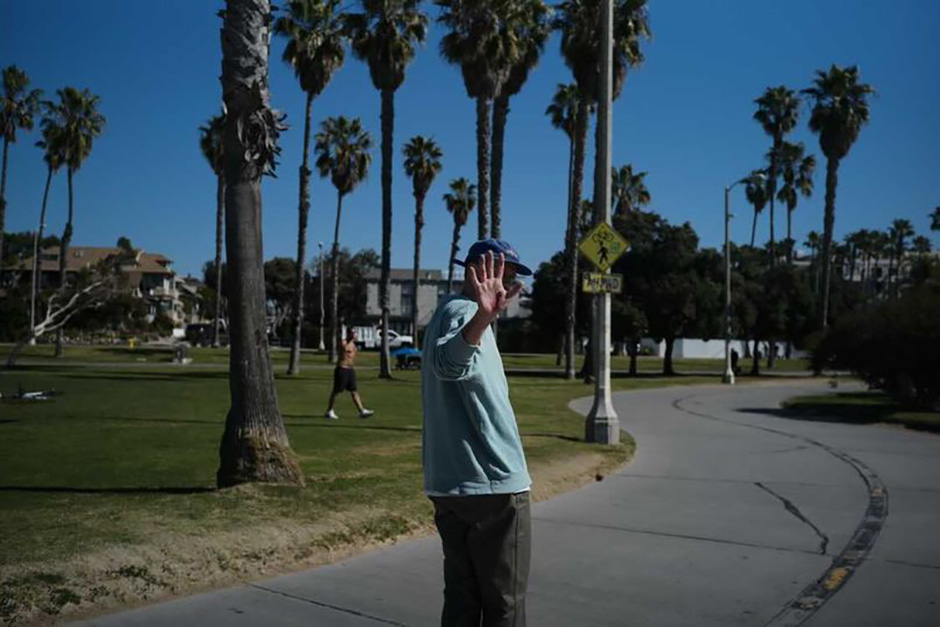
Farewell from Los Angeles. ph: David Serrano
We would like to thank Paul for his time and patience and all of the photographers who contributed to this piece – Wig Worland, Tim Leighton-Boyce, Andy Horsley, Sam Ashley, Oliver Barton, Pete Thompson, Dominic Marley, Josh Stewart, Leo Sharp, Henry Kingsford, Joey Guevara, Zander Taketomo, Nestor Judkins, Jeremy Adams and David Serrano – alongside Dan Adams for trawling the RaD Archives and sending us TLB gold from the early ’90s and ScienceVsLife for scans.
Another big thank you to Wig for resurrecting the switch backside flip sequence and breathing new life into it. We’re also hyped Jason Davey sent us the photo of Paul’s early Panic pro boards which he had a hand in designing and getting ready to be screened while working for Faze 7.
Previously by Jacob Sawyer: Daewon Song Interview: It’s never too late to progress and never too late to come back when you think that’s it”, Benjamin Deberdt: London / Paris / New York, LIGHTBOX: Karl Watson by Mike Blabac, Catch Up with Pontus Alv, Ode To Victoria Benches with Dan Magee, Nick Jensen and Toby Shuall.

